21. Unidragon’s Fiery Fox and Amsterdam
Assembly and review of the “King Size” (308 pieces) version of this Russian-made puzzle, and their smallest version (125 pieces) of City Evening Amsterdam. (about 5200 words; 45 pictures)
Fiery Fox
Made by Unidragon artist and cutting designer not identified
laser-cut 3 mm MDF (medium-density fibreboard)
308 pieces nominal 15.7” x 10.6” about 2.6cm²/piece
City Evening Amsterdam
Made by Unidragon artist and cutting designer not identified
laser-cut 3 mm MDF (medium-density fibreboard)
125 pieces nominal 16cm x 23 cm about 2.9 cm²/pc
Introduction
As I write this today I am sitting at my desk typing into my computer. I don’t know what I was doing at this time yesterday, but I have a pretty good idea what I was doing exactly one year ago. I was either sitting at my table immersed in assembling my first adult wooden jigsaw puzzle, or I was doing online research into where and how I could buy more of these wondrous toys for grownups.
That first puzzle was Unidragon’s Serious Panda. I had done wooden jigsaw puzzles as a child of course, and cardboard ones as a young adult. But that was over forty years ago. My last puzzle back then had a poorly-printed photographic landscape image and thin pieces. I think that I probably completed it out of pure stubbornness because I had lost interest in caring where exactly the right places were to put those flimsy four-sided cardboard squares with knob connectors.
That first Unidragon puzzle was an eye-opener for me. It had the bright colours that modern printing technology enables, and the interesting piece shapes made using wood and modern laser cutting. And it was not just the whimsy pieces that I liked (although they appealed to me too.) I enjoyed the interesting shapes of all of the pieces, their rich tactile feeling on my fingertips, and the satisfying click the wood pieces made when being placed in the puzzle.
I had not known about wooden puzzles for adults until I saw a Unidragon ad while waiting for a YouTube video to begin about a month earlier. Usually I am pretty immune to those advertisements but I watched that one to the end, and then watched it again. I must admit that it was the whimsies that first caught my attention. The idea of such a wood puzzle seemed like it would be a good Christmas gift for my friends Greg and Beth, who I knew liked to do jigsaw puzzles. After looking at the various artwork that was available from Unidragon’s Amazon store I ordered Fiery Fox for them.
That should have been the end of it for me but it wasn’t. I found myself going back to look at Unidragon puzzles and got more and more intrigued by the idea of wood puzzles. I decided to order one for myself if Beth and Greg said that they liked theirs and told them that I was looking forward to hearing their feedback. So after Christmas they prioritized assembling it. They did enjoy it, so that is when I ordered Serious Panda. It arrived quickly and I began assembling it immediately.
It wasn’t long before I learned about other brands that have artwork that appeal to me more, and this newsletter/blog series documents my continuing exploration into the world of wooden puzzles. In fact, I hadn’t assembled another Unidragon puzzle since that time. Greg and Beth live about 100 miles from here, and between Covid and gas prices we don’t see each other very often these days. But a while ago Greg came down to Victoria and I finally borrowed their Fiery Fox puzzle. This one-year anniversary seemed like a good time to write a review about it and about the Unidragon company.
I still have fond memories of Serious Panda, and look forward to assembling it again, especially now that I know about the extra pleasures that can be had by flipping puzzles over after they are completed (more about that below.) But I can’t rely on my memories from a year ago to contribute to my comments in this review. Back then I had not known what to expect from wooden puzzles, or what to look for when assessing them. Fortunately, just as I was completing my review of Fiery Fox my friend and former colleague John Coe loaned me City Evening Amsterdam (which I’ll just call Amsterdam) which he had received as a Christmas present. It is an example of both a different cutting style and a different style of artwork from Unidragon.
Unidragon’s artwork
Unidragon is a Russian company that was apparently founded (or at least it went international) in late 2019. Their initial puzzles were animals and mandalas with this style of artwork, which it commissions from Russian artists. A number of their earlier and most popular puzzles are like Fiery Fox and Serious Panda – very colourful renderings of animals and animals’ heads with a patchwork-like mixture of colours, textures and patterns.
Unidragon’s artwork style was an immediate international hit. Based on that, and the fact that Unidragon seems to spend more on advertising than any other wood puzzle maker, the company grew quickly. Now I can’t shop for anything on Amazon, or try to track down any wood puzzle companies using Google, without wading through many Unidragon ads that appear before whatever it is that I am looking for.
Of course, in the world of international commerce the sudden immense popularity of Unidragon puzzles and this artwork style also has its drawbacks for the company. Unidragon seems to be the one that has the biggest problem with counterfeiting and online marketing scams. They even have a page on their website discussing this problem. Besides scams and fakes, legitimate puzzle-makers commission their own animal portrait artwork in the artistic style that they popularized. The internet is now filled with puzzles of varying quality depicting animals that are a patchwork of colourful textures and patterns (and even packaged in wood boxes copied from Unidragon’s design.)
I had thought that the artwork might be a Russian style of folk art but apparently that is not the case. It is a style that had become popular in Russia based upon a form of meditative drawing called zentangle that originated in the US. Artist/calligrapher Maria Thomas and Buddhist monk Rick Roberts are credited with having invented zentangle drawing in 2003. My impression is that it is rooted in Tibetan Buddhist sand mandalas, the background filler patterns in medieval illumination, and maybe the Art Nouveau way of filling spaces with mature-inspired patterns.
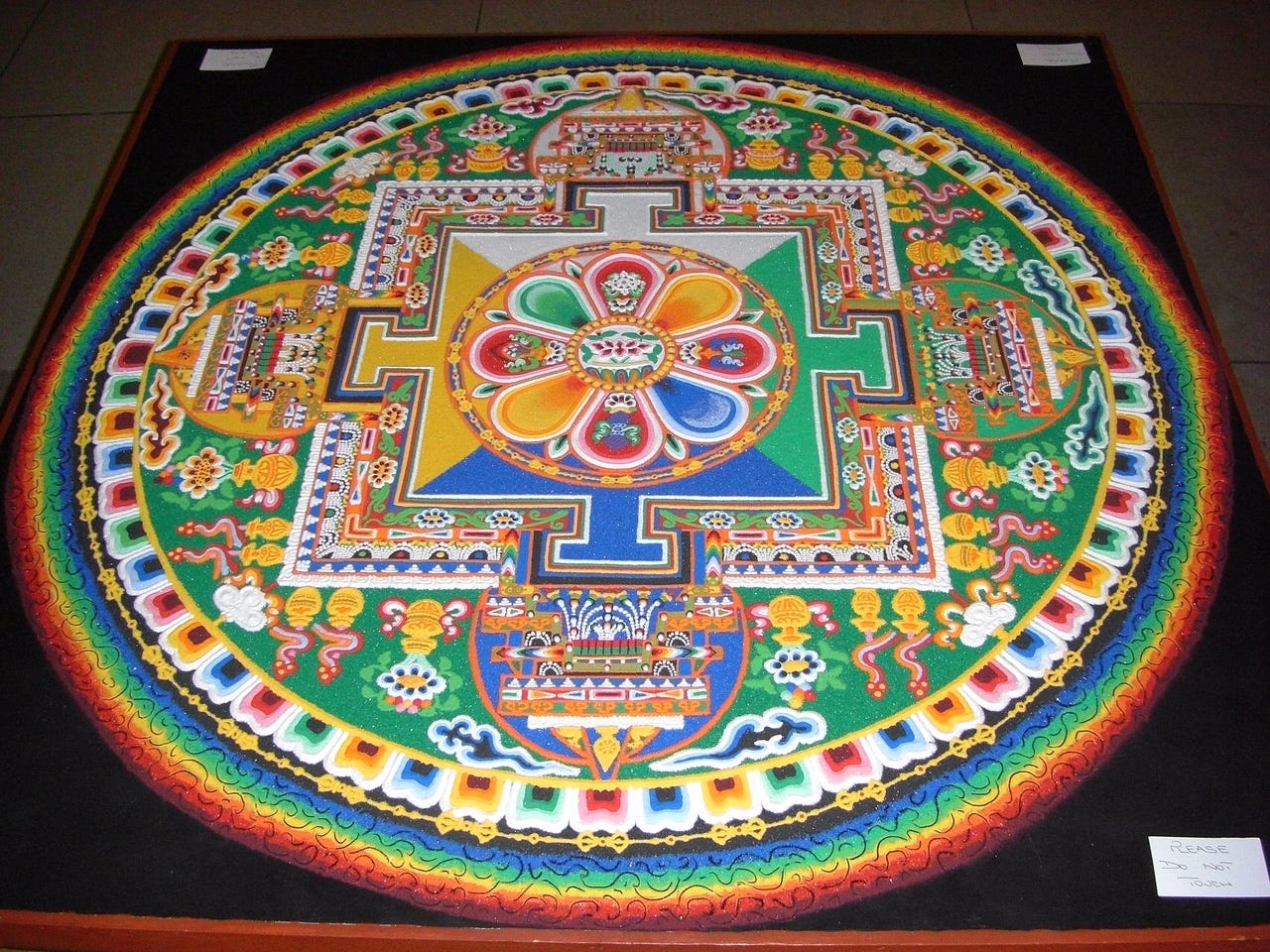
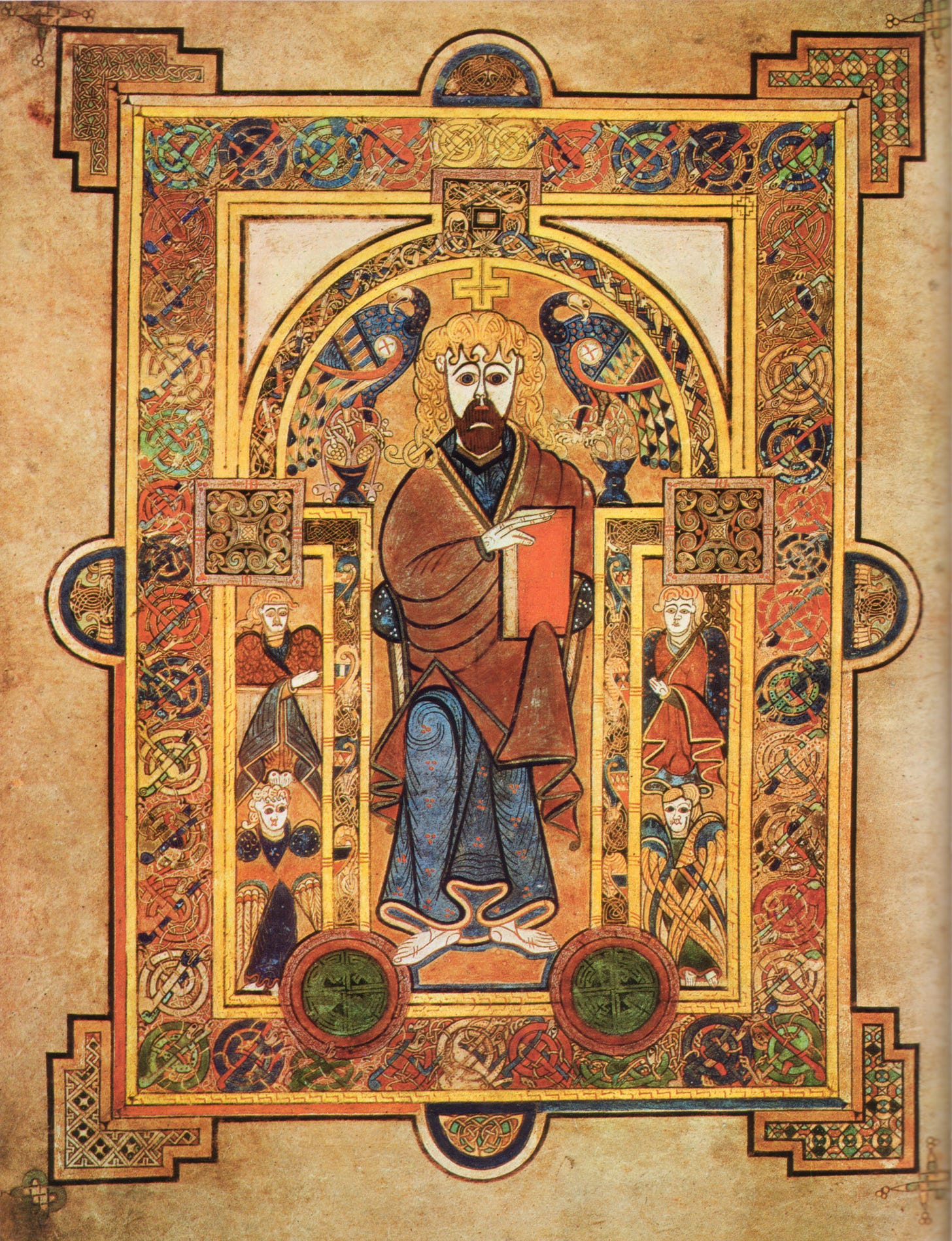

Or perhaps it just came from prolonged exposure to American currency:

Both Serious Panda and Fiery Fox have this style of artwork. More recently, Unidragon has begun making puzzles with other artistic imagery, including large-scale fine art puzzles. They also use photographs showing distinctive landscapes from around the world, seemingly always with vibrant colours that have been juiced-up using digitized image processing. City Evening Amsterdam has that latter style of image.
Packaging and first impressions
Unidragon puzzles arrive in an attractive storage box made from the same 3mm MDF (medium density fibreboard) as the puzzle itself enclosed within a corrugated outer box. Greg and Beth kept both boxes and in retrospect I wish that I had kept my outer corrugated box too. While the wood storage box is attractive it is not functional: It cannot be securely closed to keep the pieces safe, and the top needs to be taped down if you do not still have the corrugated box to keep the wooden box closed.
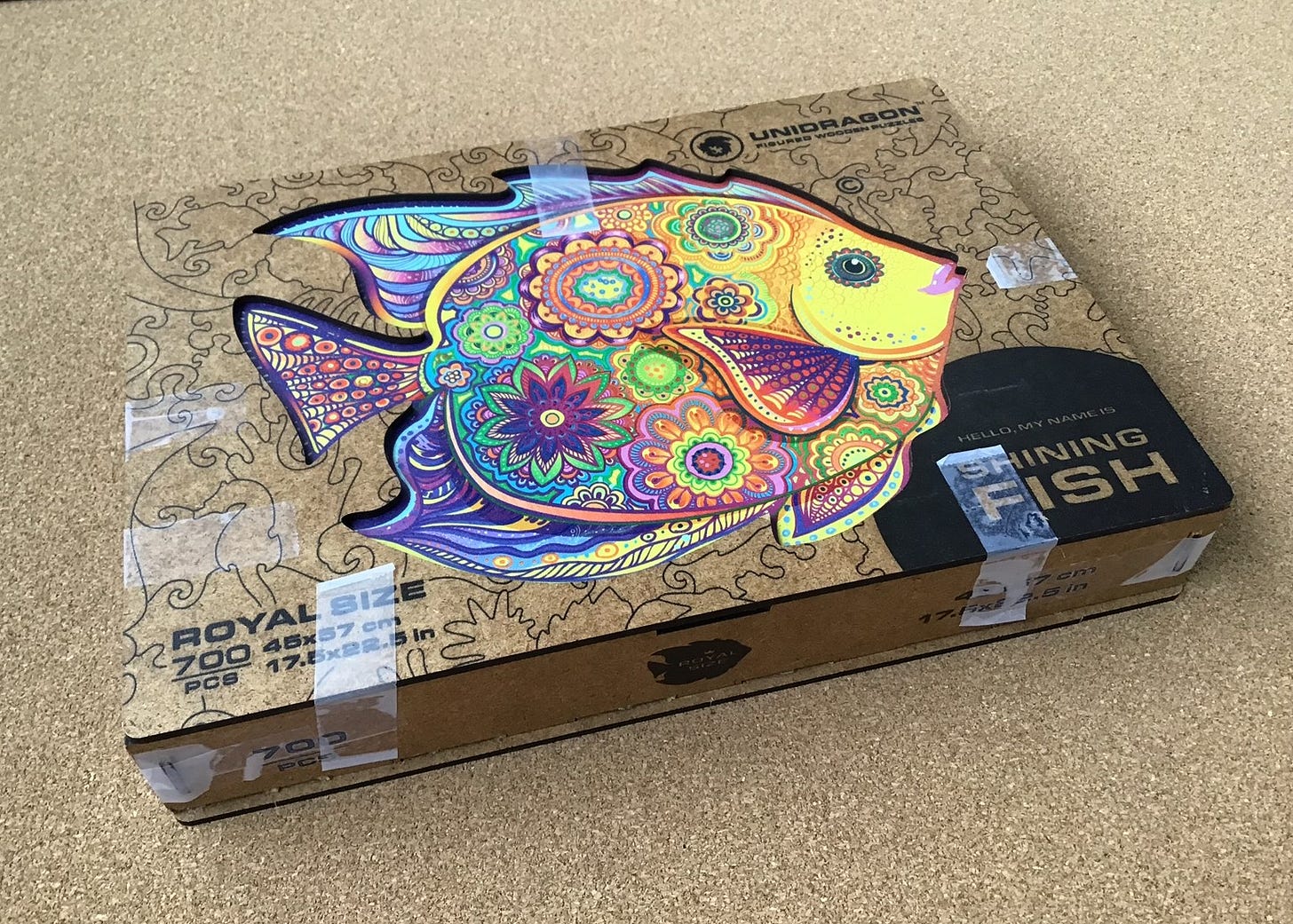
Although the storage box is not functional it is good looking. My larger sized Unidragon boxes have an image of the puzzle’s artwork UV-printed onto wood that is inset into the cover. Inside the box there are two pieces of MDF that work as a stand to hold this cover upright for those who want to use it for reference during assembly.
Also inside is a burlap liner sheet that makes for attractive presentation but which is also not very functional. The coarse burlap snags puzzle pieces (making it likely that a “missing piece” is actually still in the box) and it sheds lots of short burlap fibers onto the puzzle-board and elsewhere. Unfortunately, in emulation of Unidragon’s very effective marketing, both the non-functional storage box and the burlap liner have been widely copied by other puzzle-makers, especially those in China.
The packaging for John’s small-sized (125 piece) Amsterdam puzzle is a bit different and more frugal. I don’t know whether that is because it is a small-sized puzzle or because it is the most recently-purchased one and Unidragon has implemented cost-saving measures. The storage box is still made from the same 3mm MDF as the puzzle pieces but the packaging is different. Instead of the printing the image inset in a 2-layer box-top it is printed on paper and glued onto the top, and it does not have the small brackets to hold the top up for easy viewing during assembly. Unfortunately, it still has the burlap liner.
Printing and cutting design
Fiery Fox has very high quality printing. It is a sharp, hi-resolution image UV printed directly onto the MDF (medium density fibreboard) with a low-gloss finish. As I have explained in previous reviews, UV printing is durable and gives very intense bright colours (iof that is what the artwork has), and I think that printing directly onto the wood is preferable to printing the image onto paper for most styles of artwork. This image calls for vibrant colours and UV printing delivers them.
The image of Amsterdam seems to have been printed on non-glossy paper which is affixed onto the MDF substrate material. Again, I do not know if this change in printing technology is being implementing across Unidragon’s line or if it is specific to small or photographic puzzles. The latter is possible because, in general, I think that photographic artwork benefits from the very smooth surface that paper enables. But unfortunately, since paper is a softer material it makes the pieces subject to more wear as bits of the top layer of paper get worn off from the corners of the pieces revealing small specks of stark-white paper that stand out in the dark areas of the puzzle (like the dark green foliage in this puzzle.) This can either be accepted as beginning the normal patina that vintage wood puzzles (from before the days of UV printing on wood) always have had, or the wear can be repaired using coloured pencils.
The cutting of both puzzles is also very well done and the swath of the cutting (“kerf”) seems to be narrower than usual for laser-cut puzzles. There is no front-side burning on either puzzle and it doesn’t even have the usual amount of back-side burning. Both puzzles do have some small, very dark, round burn marks that I don’t recall noticing on the backs of other puzzles, apparently where the laser lingers slightly to make a tight turn. But back-side burning is so common among the various wood puzzle brands, including premium ones, that I don’t consider it to be a significant quality control flaw.
The most obvious feature of the cutting design for both puzzles is that they have a fitted outside shape instead of being a rectangle. There is a black border around the outside of the Fiery Fox image that makes most of the edge pieces recognizable. I thought that this would aid in assembly but it didn’t. In fact, some of the edge pieces were very well disguised with a few jogs, and that makes the puzzle much more challenging than if it was a simple rectangle. In general, puzzle companies that sell puzzles with both regular and shaped edges usually charge more for this irregular outside edges.
Amsterdam is basically the shape of a landscape photo, as befits its artwork, but the shape is made sufficiently irregular that assembling edge-first would not be a very promising strategy.
Fiery Fox has at least 30 attractive-but-unexceptional whimsies, and it includes a 19 piece figural of the fox’s face (shown near the end, after the Spoiler Alert.) Here is a representative sample of its whimsy pieces:

There is a lot of attention to detail in the placement of the figural pieces in Fiery Fox. I don’t really think of them as being multi-piece figurals, but many of them are located in relationship to each other and with distinctively-cut non-figural background pieces that seem to create mini-scenes that can only be appreciated after the puzzle is turned over. These were an unexpected treat, indicative of high-quality cutting design.
[Note: I don’t know why Unidragon does not suggest that people turn their puzzles over after completion sine they have this very appealing feature, and include instructions about how to do so either in the box or on their websites. I know from my own experience that turning puzzles over is not intuitive. I only began after learning about it from the Wooden Jigsaw Puzzles Club group on Facebook, and many newbies to that forum also first learn about the trick there.]
Here are two examples of back-side mini-scenes:
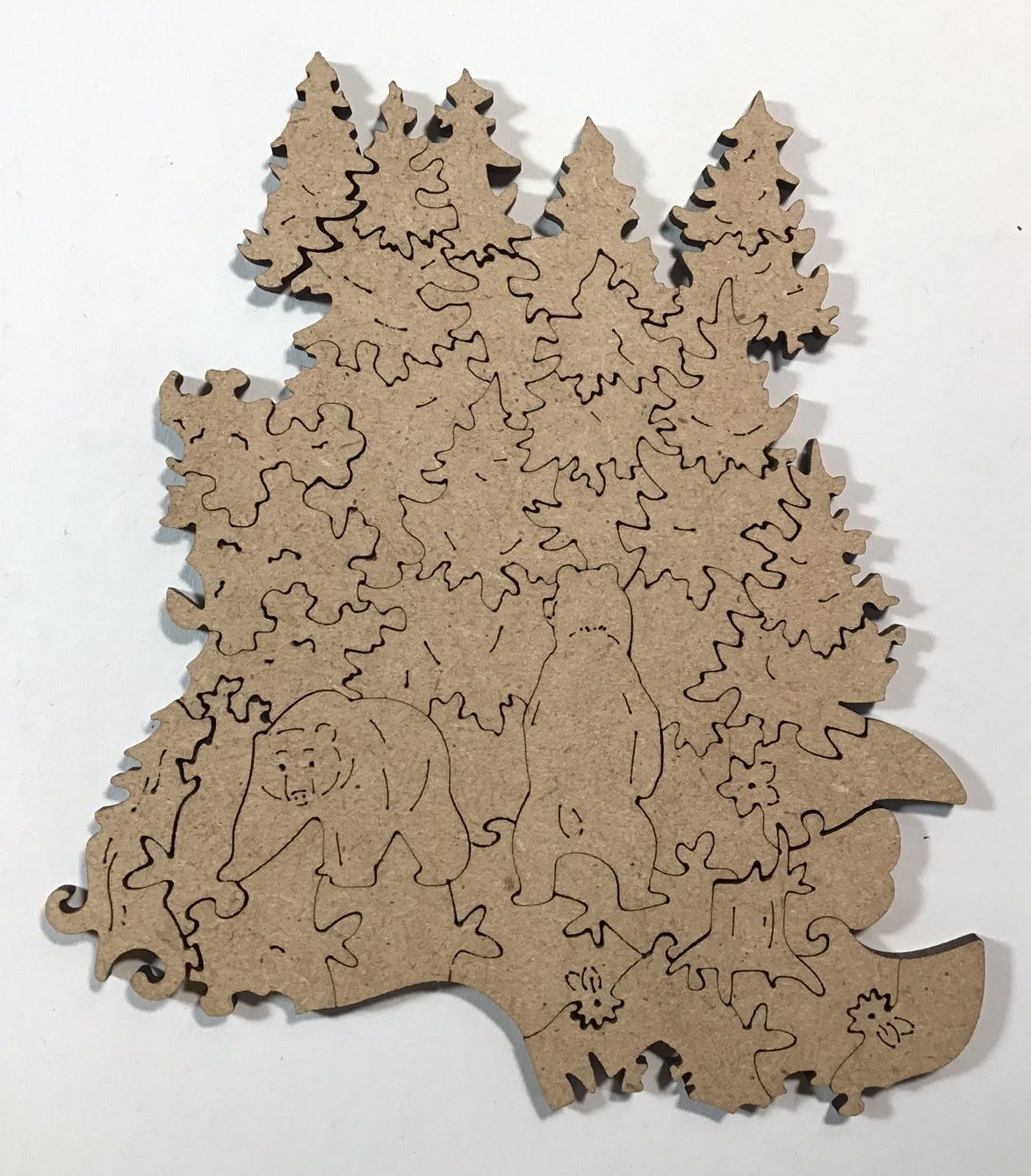
Other areas also have partially-figural pieces that give an impression of bushes (rather than trees) or other cutting of non-figural pieces that give a distinctive character to different areas of the puzzle (shown at the end, with the assembly after the Spoiler Alert.).
One result of this use of non- or semi-figural pieces to help create mini-scenes is that the puzzle is not as fully interconnecting as ones that use traditional knob connectors. On the other hand, it also results in more interesting shapes for the non-figural pieces, and I think that the overall effect is that it both makes assembly much more interesting and adds to the challenge. All-in-all, I consider the cutting design for Fiery Fox to be particularly creative, sophisticated and enjoyable.
The placement of the whimsy pieces in City Evening Amsterdam is more typical of a standard wooden puzzle, and there are no multi-piece figurals:
The figural pieces in both puzzles are placed in the proper orientation relative to the image (an attention to detail that I appreciate) and none of them seem to be particularly small or fragile. Their shapes are suitable for their respective artwork but I do not have sufficient experience with Unidragon puzzles to be able to tell if they are designed specifically for these puzzles or if they are drawn from a pool of generic whimsy patterns. My guess is that it is the latter.
The images
Except for a few large 1000-piece fine art puzzles Unidragon does not identify who creates their artwork. I know from “Puzzle Evangelist,” the handle of the Russian founder of the international Facebook group Wooden Jigsaw Puzzle Club, that they commission images from at least 10 artists in a variety of artistic styles, many of which are not currently readily available in most countries.
I found the Fiery Fox image made a very appealing and moderately challenging puzzle. As has happened to me before, I especially enjoyed watching the image develop after I had the eyes and central part of the face in place and I had the green eyes of the fox staring straight at me as I worked on completing assembly. Only after the puzzle was complete did I realize that one reason those eyes stood out so vividly is that there is very little other green in the image.
This style of artwork includes some colour areas, such as the blue-white muzzle and the red-dominant cheeks, and other distinctive small areas of colour, texture and pattern to support colour matching. But the general effect of so much busyness is that it is quite challenging. Sometimes I found that the lateral symmetry of the image was helpful: The patterns and textures on both sides are quite similar but not mirror images. In general, the bright vivid colours made the challenge very enjoyable.
Since Amsterdam has a photographic landscape image like the cardboard puzzle turned me off of jigsaw puzzles over 40 years ago I probably have a bit of a bias against this style of artwork. Amsterdam is only the third photographic landscape or architectural puzzle that I have assembled in the past year. The image itself is sharp and clear, and it was certainly colourful – arguably too much so, since the image processing and juicing up of the colours is certainly not subtle. But overall, I think that it is somewhat darker than I and most other assemblers would prefer.
While I appreciate the added challenge of an irregular edge, the ragged look seems out-of-place for a landscape photographic image. Also, both the foliage and architectural details seemed to be to fine-grained in relation to the piece sizes for this puzzle. But that is probably since this is a small puzzle, 6.2” x 9” (16 x 23 cm), and the same image is used for Unidragon’s Medium and “King Size” puzzles. I think that the photo would be much more effective in those sizes.
Quality control and customer service
There were no significant quality control problems with any of the three Unidragon puzzles (including Serious Panda) that I have assembled. There was some very minor front-side smudging on City Evening Amsterdam but that was not bad enough to be worth complaining to the company about, and I only mention it because I want this review to be complete. There was therefore no need for me to test Unidragon’s customer service. But the other puzzle that I bought from the company - the “Royal Size” (700 piece) Shining Fish which I haven’t assembled yet - does present some questions about whether one can count on the company to support their products, and that is compounded by the fact the current political situation of Western countries boycotting Russia probably adds to the difficulties of getting a resolution if a problem were to arise.
When Shining Fish came last February the corrugated outer box showed no sign of rough handling but the inner wooden box was broken open. Since there was no evidence of crushing on the corrugated outer box it must have been put into the outer box in that condition. The broken wood box appeared to be quite repairable, and like my Serious Panda box I knew that it would never have provided secure storage anyway unless the top was taped down. A cursory inspection of the pieces did not show any damage to them, and there were no stray pieces in the outer box.
Like my other Unidragon puzzles it included the following insert requesting that such problems be reported to the company for resolution rather than giving the puzzle a bad online review:
I can appreciate that the company doesn’t want people to immediately post a bad review if they are willing to back up their products with good customer service, and the request for feedback seemed sincere until I saw that there is no email address provided to reach Mr. Ruzheinikov’s office in the message. I could also not find such an address on either the website of the company in Russia (using Google translation) or on the website of the company’s North American distribution branch (now known as Rusard US Inc) based in Alexandria, Virginia.
I tried to contact both the Moscow and Virginia offices with my feedback through their “Contact us” communication options. I did not ask for any remedy, since the box appeared repairable, but I did think that they would appreciate getting feedback about an apparent quality control problem. I also wanted to have a report about the as-arrived condition on record if there does prove to be a missing or broken piece problem when I get around to assembling the puzzle. (Since the puzzle has 700 pieces I correctly anticipated that I would want to wait until my puzzling skills felt up to such an assembly challenge. I’m still waiting to feel ready for that. The largest wood puzzle I’ve assembled to date is still under 600 pieces.)
I never received a reply or even an acknowledgement of receipt from either of those messages. That was before the Russian attack on the Ukraine, but there was already a lot of coverage in the news of the build-up for it, and speculation about what the West’s responses might be if there were to be an attack. I still don’t know whether the failure to respond was due to staff being too busy at that time trying to prepare for the disruption, or whether poor customer service is standard practice for Unidragon.
In preparing for writing this review I posted a message in the Wooden Jigsaw Puzzles Club discussion group on Facebook asking about other peoples’ experience with Unidragon customer service. The answers varied, ranging from folks who had received satisfactory service (but sometimes only after doing some pestering) to those who were very unsatisfied and had sworn off ever buying from the company again. A few people mentioned that they had been unable to get a resolution via standard customer service correspondence but that they did get an immediate satisfaction after posting a complaint on Instagram. Apparently, the company’s social media staff have more clout to get a resolution than the customer service staff.
Overall impressions and availability
Since Unidragon puzzles are only 3mm thick my standard of comparison would normally be to compare these puzzles to other 3 and 4mm wood puzzles, like Wentworth or the various Chinese-made wood puzzles, and not the more expensive 5 or 6 mm thick premium-quality puzzles. However, for their various sizes (unless they are on sale from a trustworthy vendor such as the company itself or its Amazon store) Unidragon puzzles are among the most expensive 3mm puzzles available possibly because of their high advertising costs. (As discussed above, there are so many online scams and counterfeits made of their puzzles I would be hesitant to buy any new Unidragon-branded puzzle being sold by anyone other than the company itself.)
As I write this, the current US price for the 308 piece “King Size” Fiery Fox is $70. That puts them up into the price range of some of the less-expensive 6mm thick puzzles (ones that do not come with premium features like fancy gift packaging, such as Whimsey Wood Puzzles reviewed here, or Nook Puzzles reviewed here.)
Woodbest’s shaped 3mm thick puzzles of comparable size which come in the same kind of non-functional wooden box (their 287 piece Viking is reviewed here) currently costs only about $50 USD. It is harder to compare Unidragon to the British-made Wentworth puzzles (back-handed review here) because of they have only a limited selection of shaped puzzles, they must be shipped from the UK which costs more, and they rarely make puzzles in the 300 piece size. But their regular price for 250 piece puzzles is only about $39 USD.
I know of two online sources for North Americans to buy Unidragon puzzles – the website of Rusard US Inc, their distribution centre based in Alexandria, Virginia, and their Amazon store. The company also has a distribution centre called Rusard Limited based in Dublin for European customers (that does not ship to North America) and I have found (but can’t find now) the company’s Moscow-based website (which I presume would not currently be able to sell to many countries.) The various websites have similar base prices but different availability and different items now on sale.
Currently, there are legal and ethical issues regarding boycotts of Russian-made products imposed by various Western countries in response to the attack on the Ukraine. I have not looked into the technicalities of the boycotts or trade restrictions but I presume that the products that are currently being sold by the company’s two Rusard distribution branches and its Amazon stores were exported from Russia before the legal restrictions were put into place, and that purchasing them would be legal for anyone living in the countries to which they ship.
As described above, as a 3mm puzzle the manufacturing of these puzzles is of a high calibre and the cutting design in Fiery Fox is up to the standard of a premium puzzle. Assembling it was particularly enjoyable. I also was a bit surprised at the degree of challenge and enjoyment that I got from the little Amsterdam puzzle. I began it with concerns about both its photographic artwork (as discussed above) and its geometric cutting pattern (discussed below) but it turned out to be a fun build. I don’t think that I would buy another small puzzle from Unidragon’s line of scenes from around the world, but I am tempted to get a king-size one despite their garish colours.
Spoiler alert
Below here are both photos and discussion about assembling the puzzles, as well as photos of the back sides which show the full cutting designs and all of the figural pieces. If you already plan to get either of these puzzles the following content might give you information that you would rather discover for yourself. On the other hand, if your powers of forgetfulness are as good as mine the following content will likely do you no harm.
Fiery Fox – assembly and completed puzzle
I had occasional glimpses at the box-cover image before assembly but I purposely tried not to study it. My general recollection was of a predominatly orange, laterally symmetrical fox face image in the Unidragon patchwork of patterns/textures style of artwork that I had already experienced with Serious Panda a year ago.
As with that other puzzle most of the edge pieces were recognizable because of a black outside border. Even though approaching assembly by doing the edge first did not seem promising, out of habit I separated them from the others as part of the initial sorting. Organizing pieces by colour mainly involved picking out the predominantly blue-white pieces and putting the others on an approximate spectrum ranging from yellow to reddish.
After trying to start with edge pieces and getting nowhere, and then trying the eyes and not doing much better, I focused on targets of opportunity where there was larger expanses of a single colour, like the yellow and red near the top of this picture, and the bluish-white and black:
I worked out from the largest island that became recognizable as the nose and muzzle, and chased down some more of the very few pieces that had any green for the eyes. I was fortunate that the yellow and red islands expanded the eyes. The puzzle now began to take on its personality, which gave me a feeling of accomplishment:
I next worked on expanding the blue-white muzzle, and the areas at the sides of the face that had a distinctive red textures and patterns:
It was about here that I thought that the blue-white area might be approaching the puzzle’s edge. I organized my prospective edge pieces by colour. After I found the first one it was fairly easy to find the adjoining ones among the blue-white edge pieces. They created places where I had a fairly clear idea of what shape of pieces I should look for among the dwindling number of blue-white non-edge pieces so the speed of my progress really picked up at this stage.
After I had placed all of the predominantly blue-white pieces progress slowed down again so I began to build up from the eyebrows. That was probably not the wisest choice because there were a lot of yellow-orange pieces to look through for the right shaped pieces.
Assembly went faster when I switched to looking for the darker orange-red pieces near the eyes . . .
. . . and that led me back to the outside edge pieces:
At this point it was mostly shape-matching, but of course that gets a lot easier when there are only a few pieces remaining.


City Evening Amsterdam - assembly and completed puzzle
As with Fiery Fox, I had a few recent glimpses of the image on the box cover but made no attempt to develop an assembly strategy based on what I saw. My memory was that it was a fairly dark photograph of an urban landscape with a brightly lit tower in the centre that was reflected in the water below.
I expected the puzzle to be a standard rectangular shape (as shown on the box cover) so to add to the challenge for this 125 piece puzzle I decided not to separate out the potential edge pieces. I did sort out the predominantly sky and foliage pieces.
I began with the sky, and then the reflection of the brightly-lit tower in the water. It did not take long before I was pleasantly surprised to realize that this puzzle has an irregular edge.
This is my first puzzle that has a rectilinear cutting design. I felt a bit skeptical about that but in this case it creates a wide variety of shapes, unlike the “tetris” geometric style of cutting that I have seen on some puzzles for sale and which hold no appeal for me.
I was able to assemble a few small clusters of architectural pieces but trying to place them into the puzzle went pretty slowly . . .
. . . so I went back to doing pieces with foliage. It was apparent that would all be in the upper half of the picture. I also made some progress with the brown wall on the left side of the image, which led to placing the bicycle pieces and completing the edge on that side.
Surprisingly slow going for such a small puzzle. That is not a complaint. Assembly was rather fun.
Progress slowed even further when there was no foliage left. I found I was getting used to the geometric cut and didn’t really mind it, but I think that I do prefer smooth curvaceous cutting to these geometric right angles.
As is usually but not always the case, things get pretty easy when there are only a few pieces left.
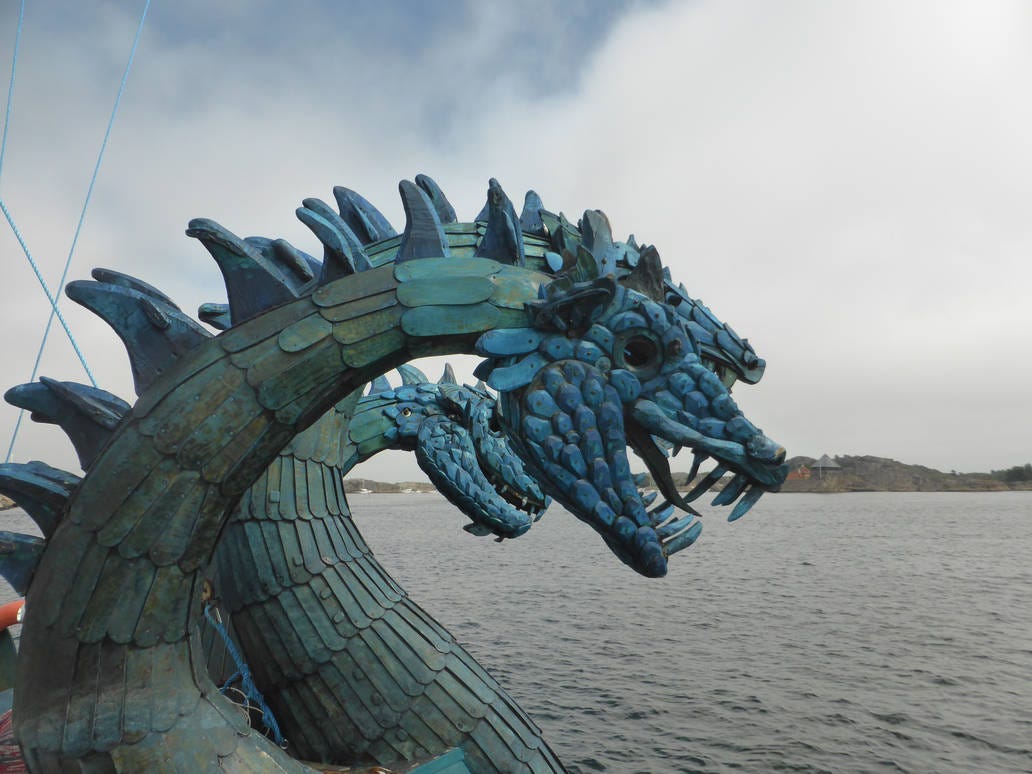




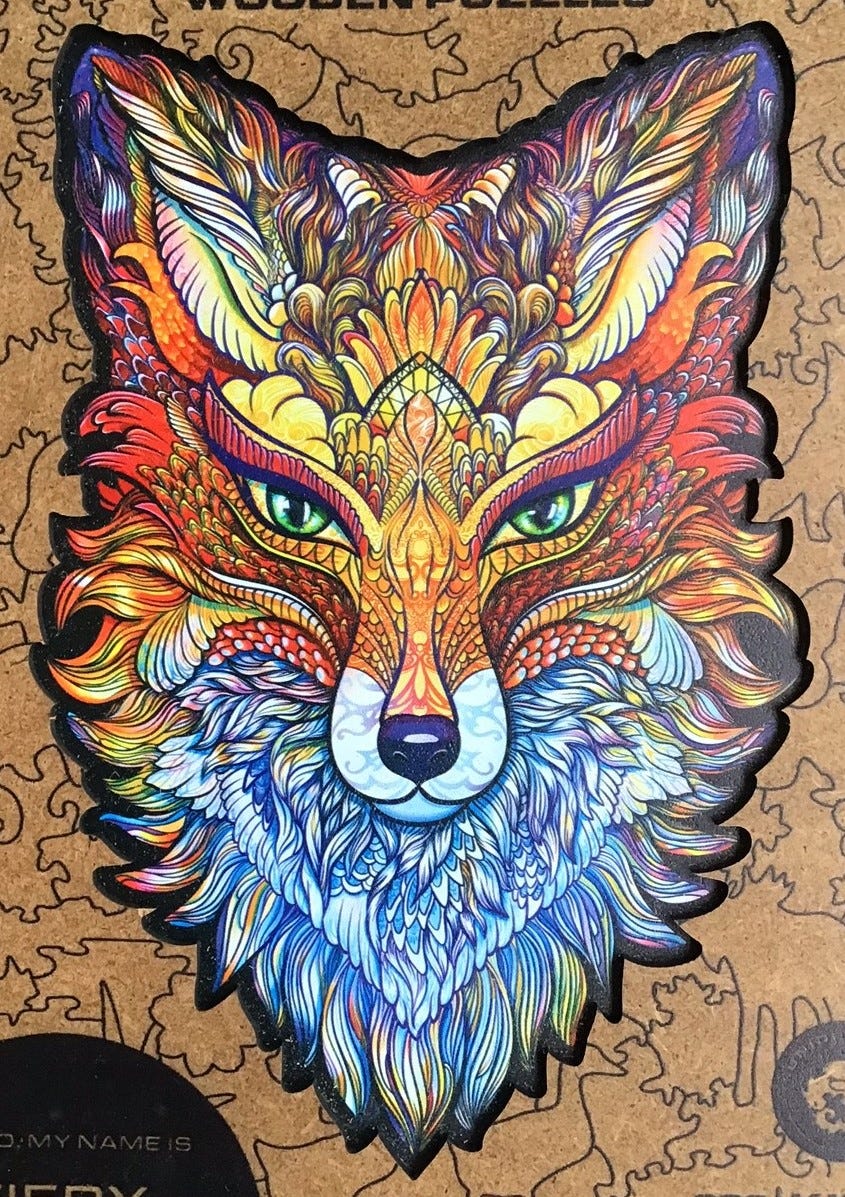
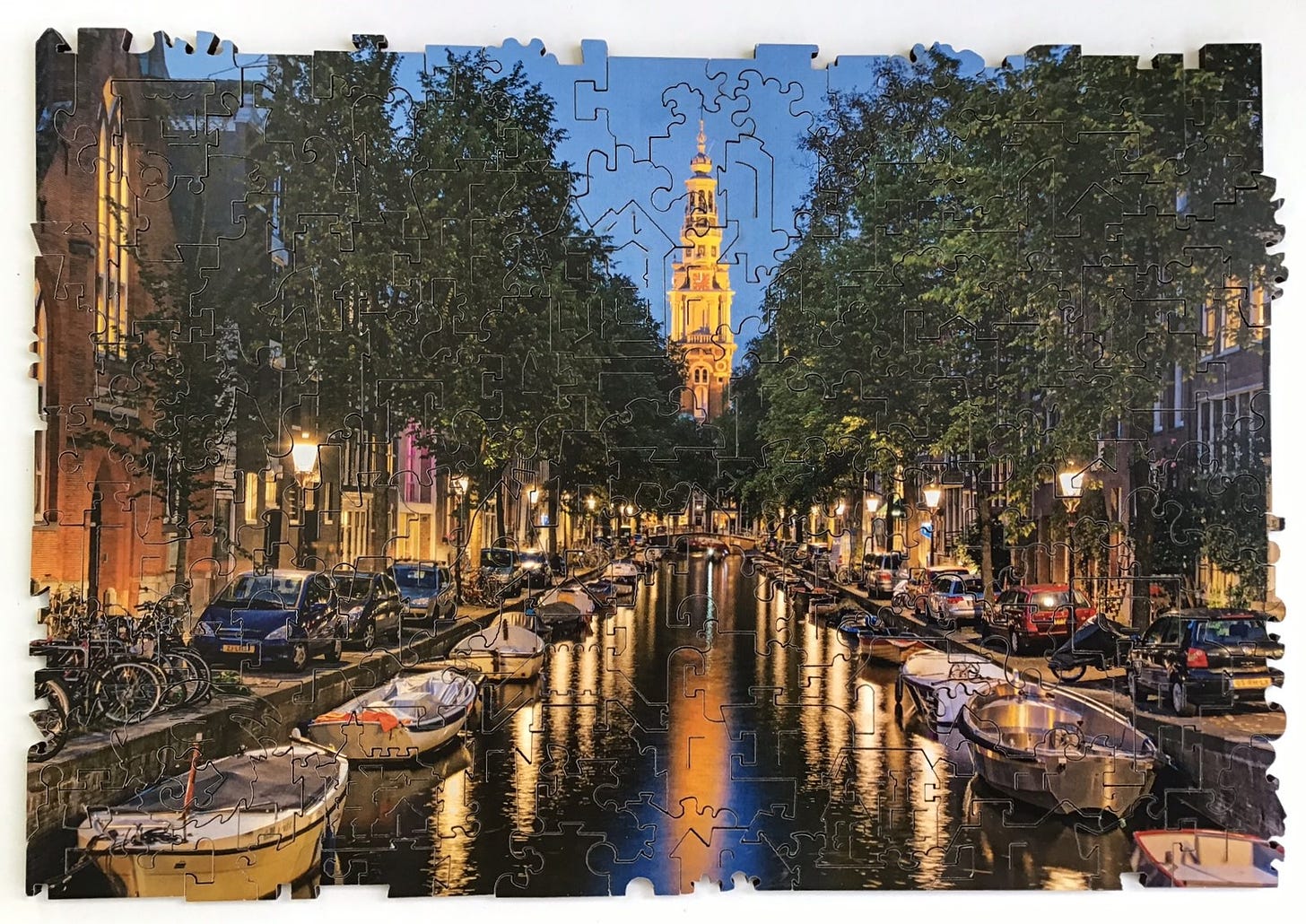
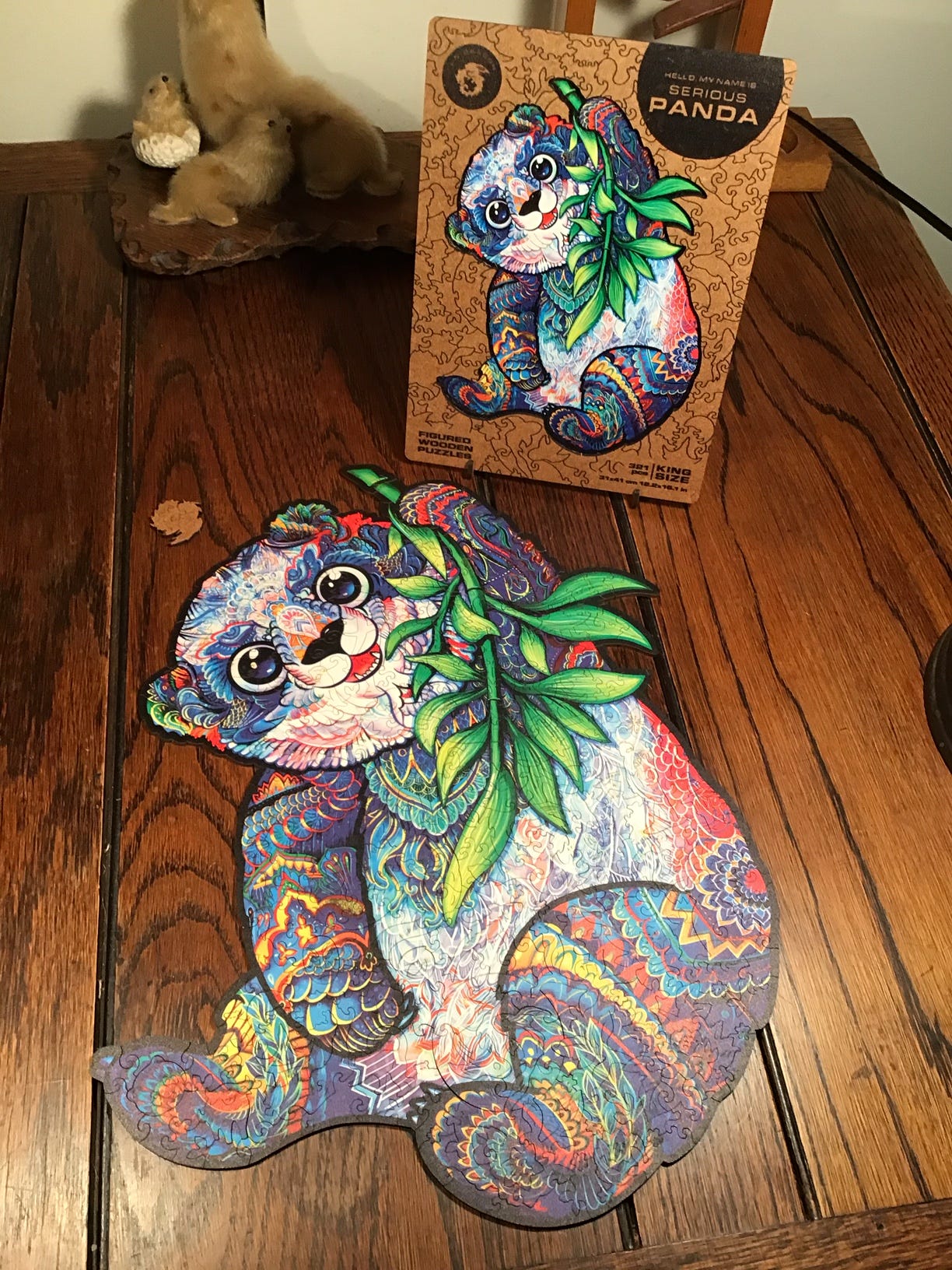
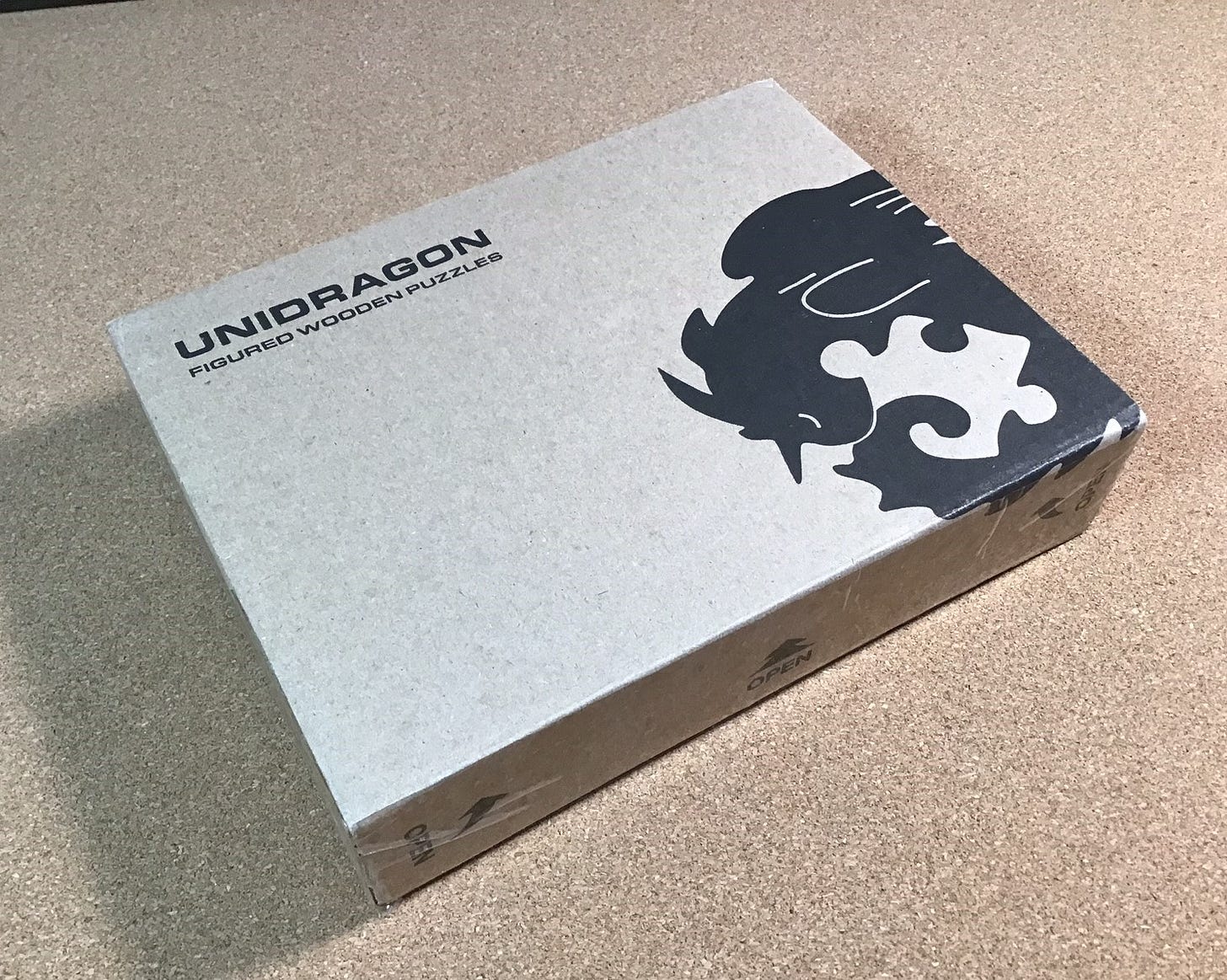

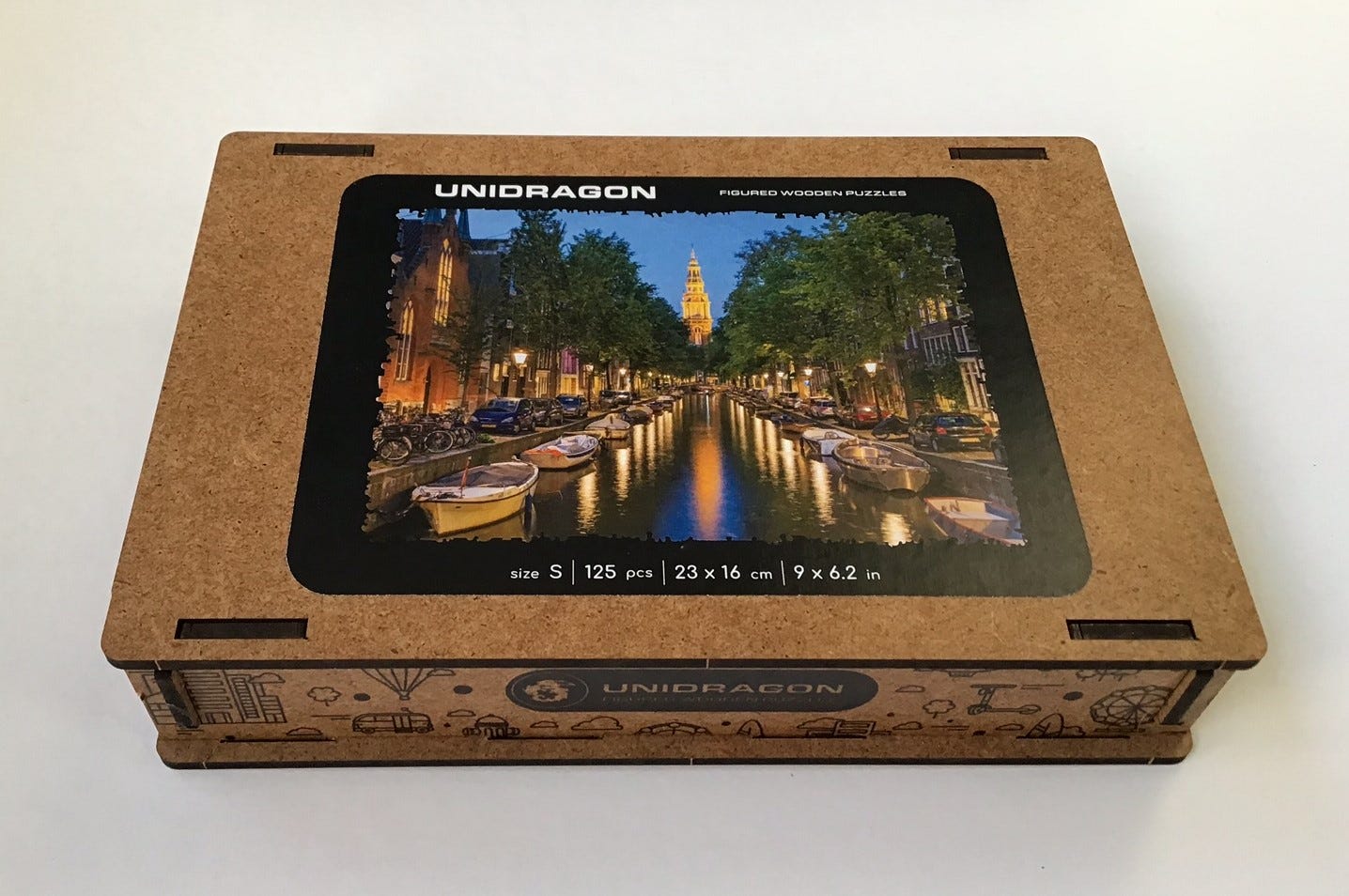

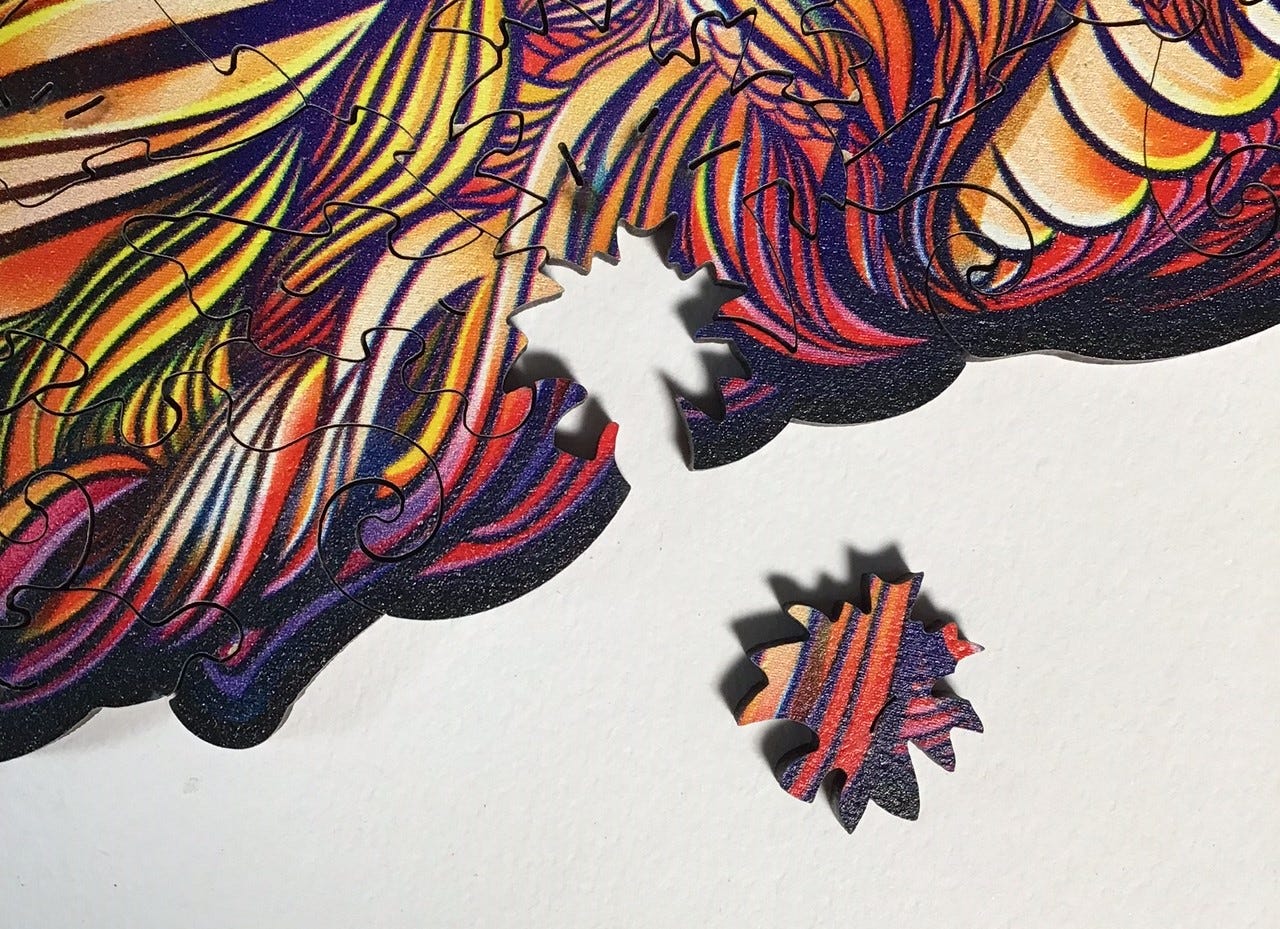

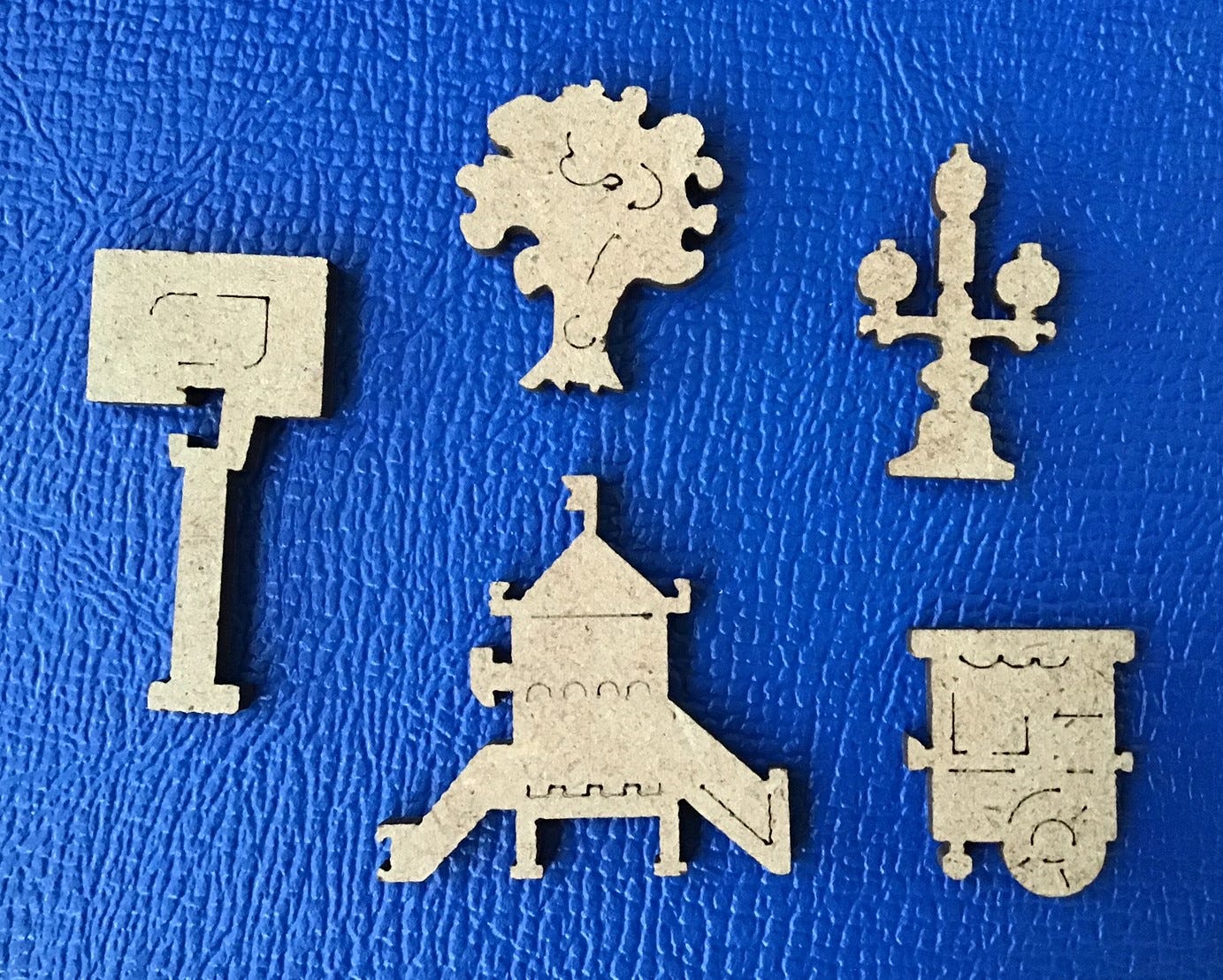
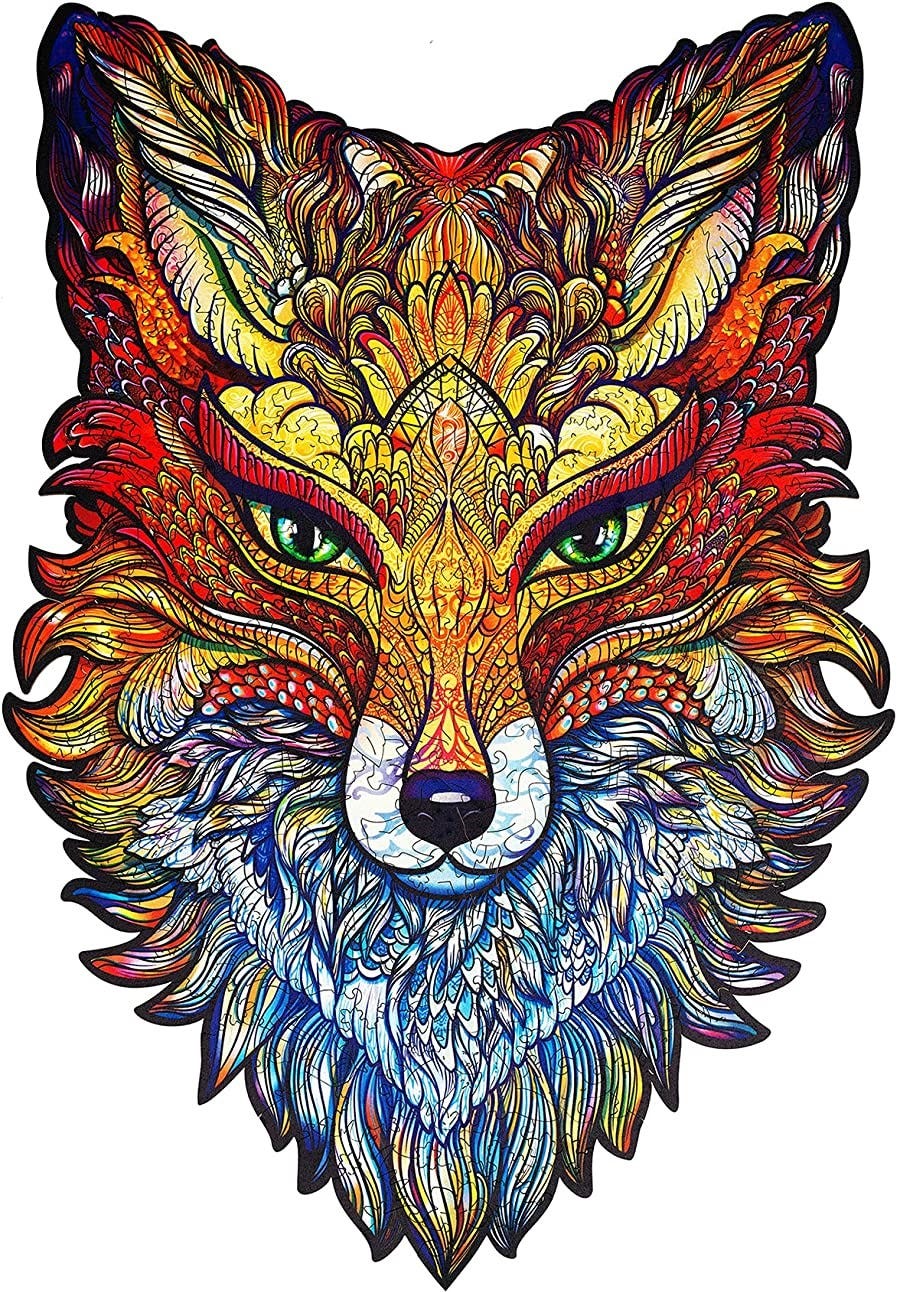
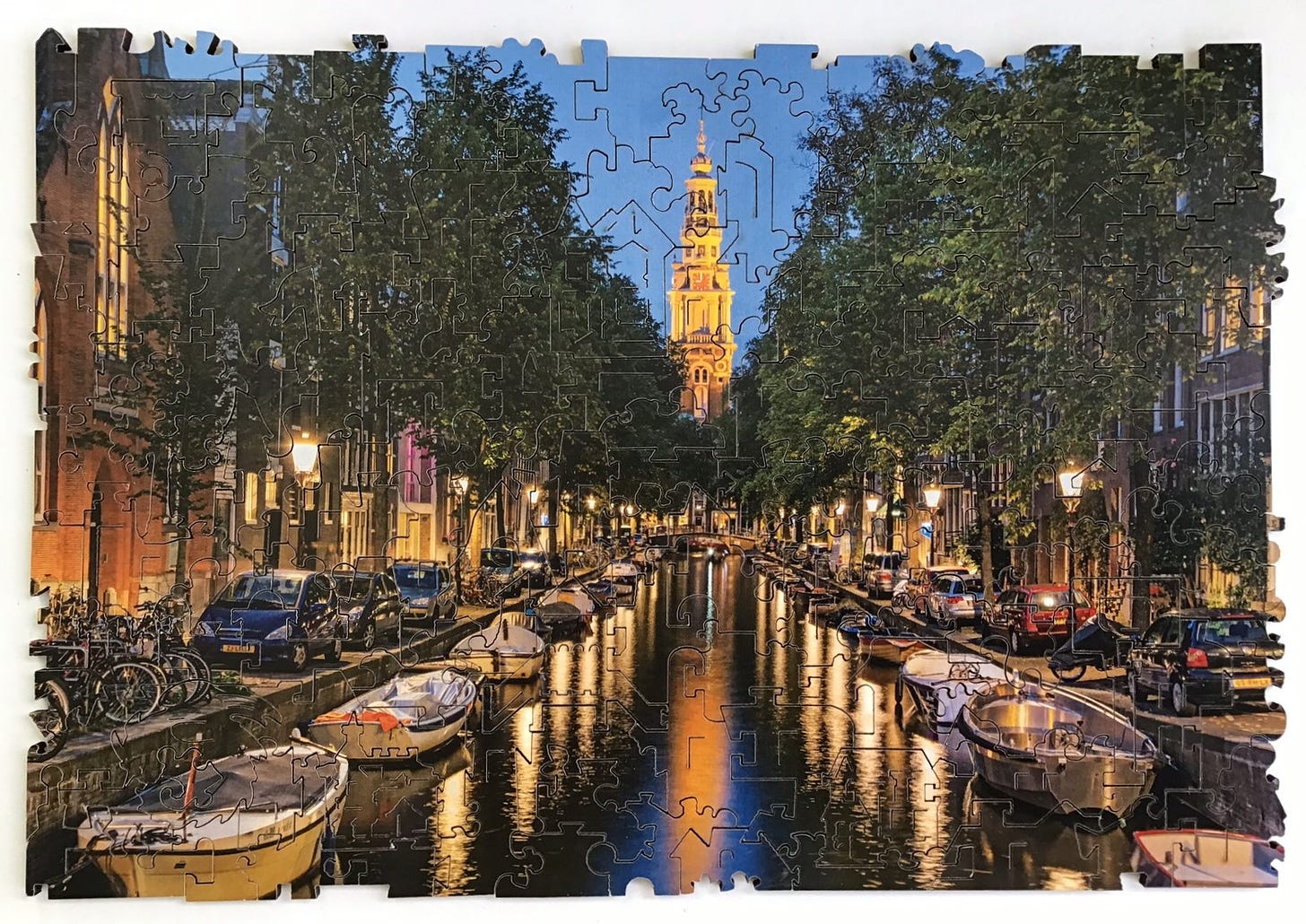
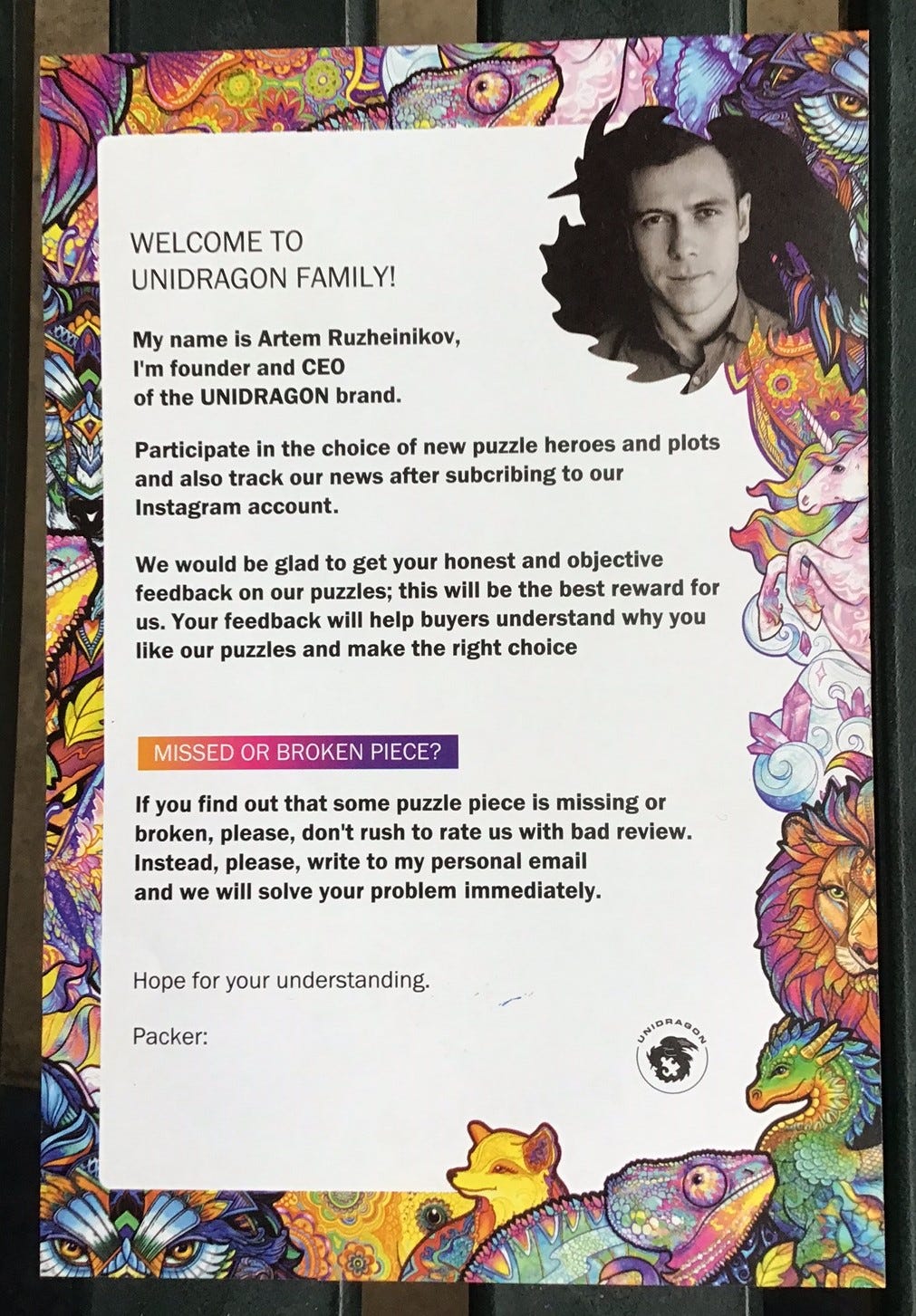
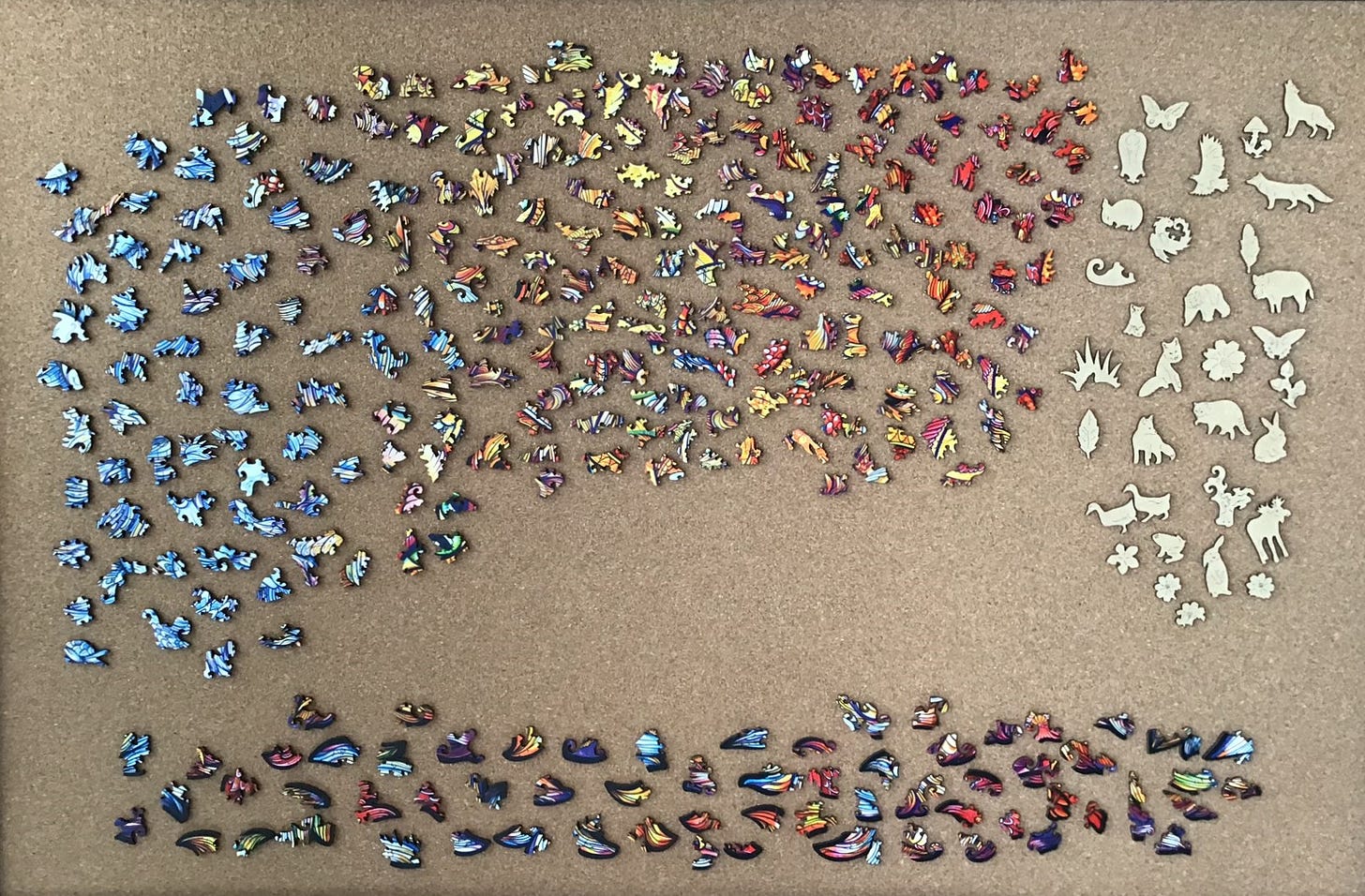
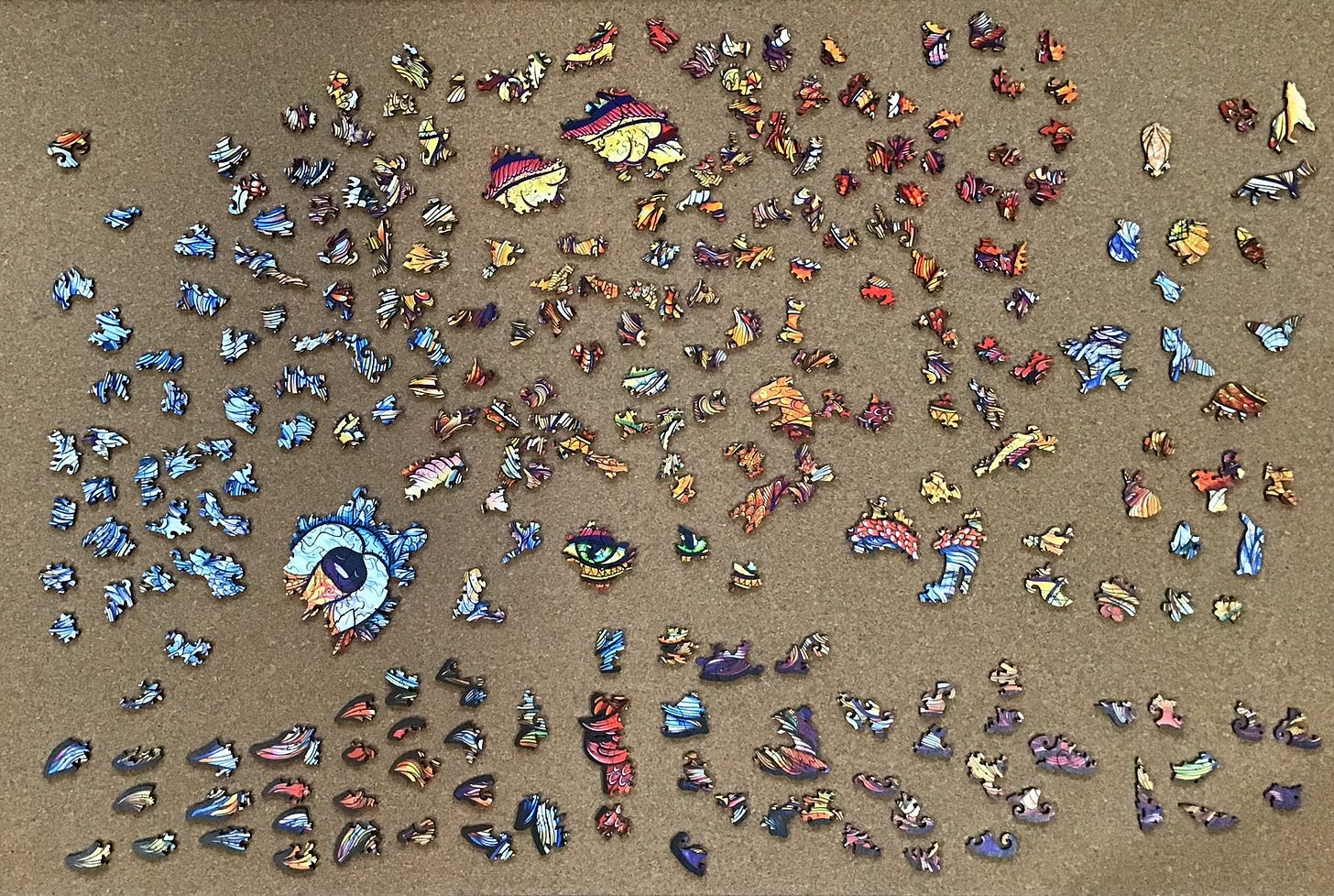
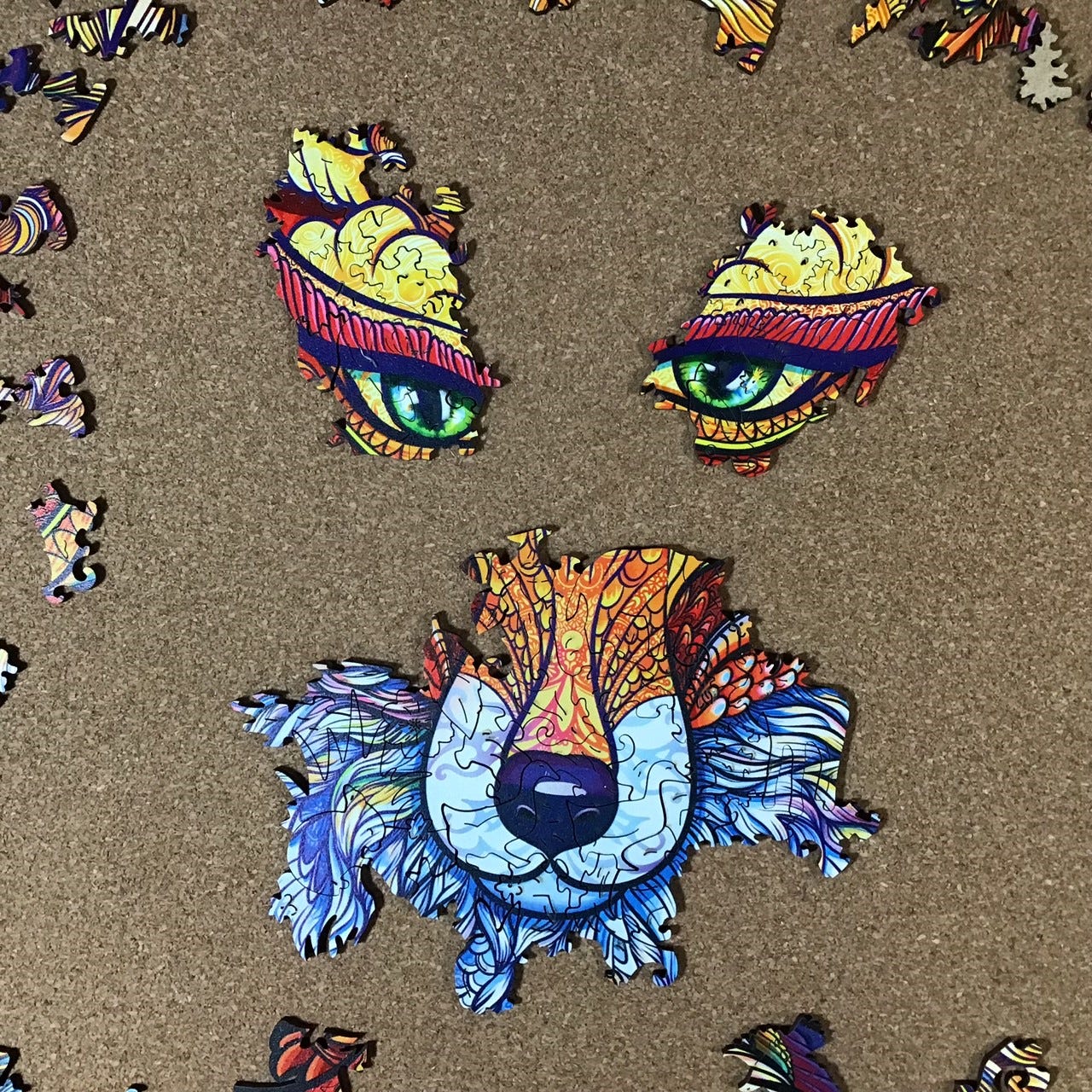


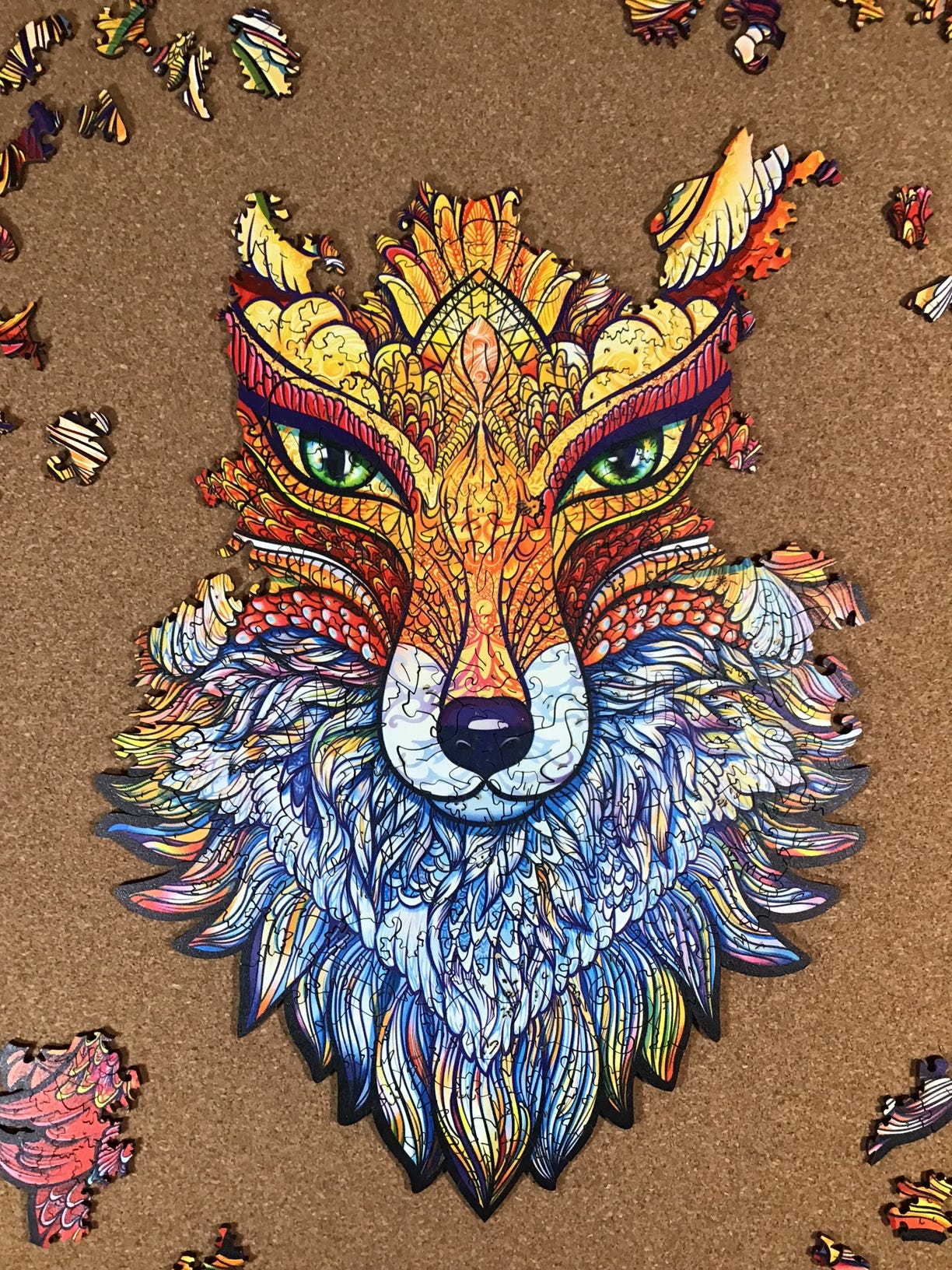
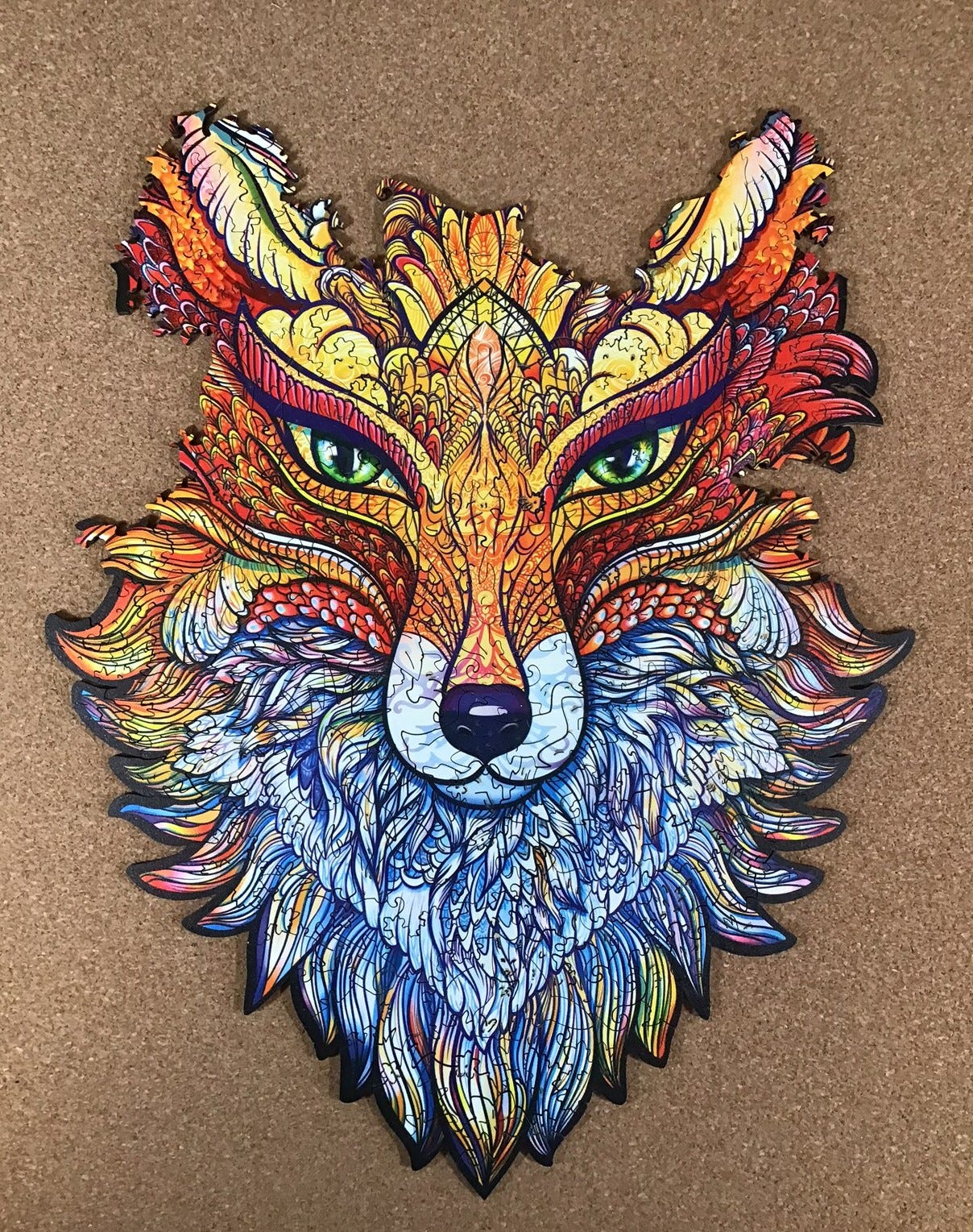


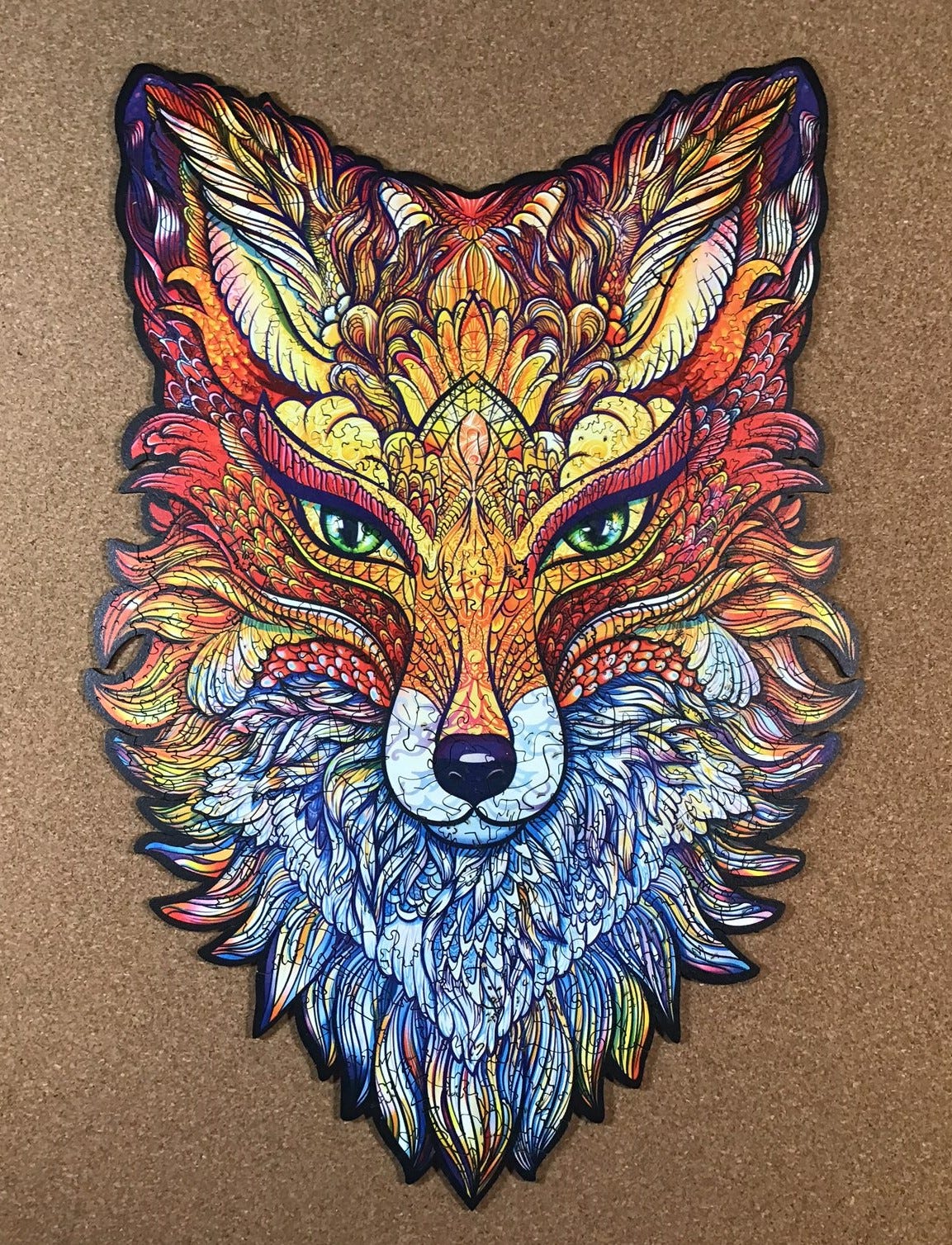
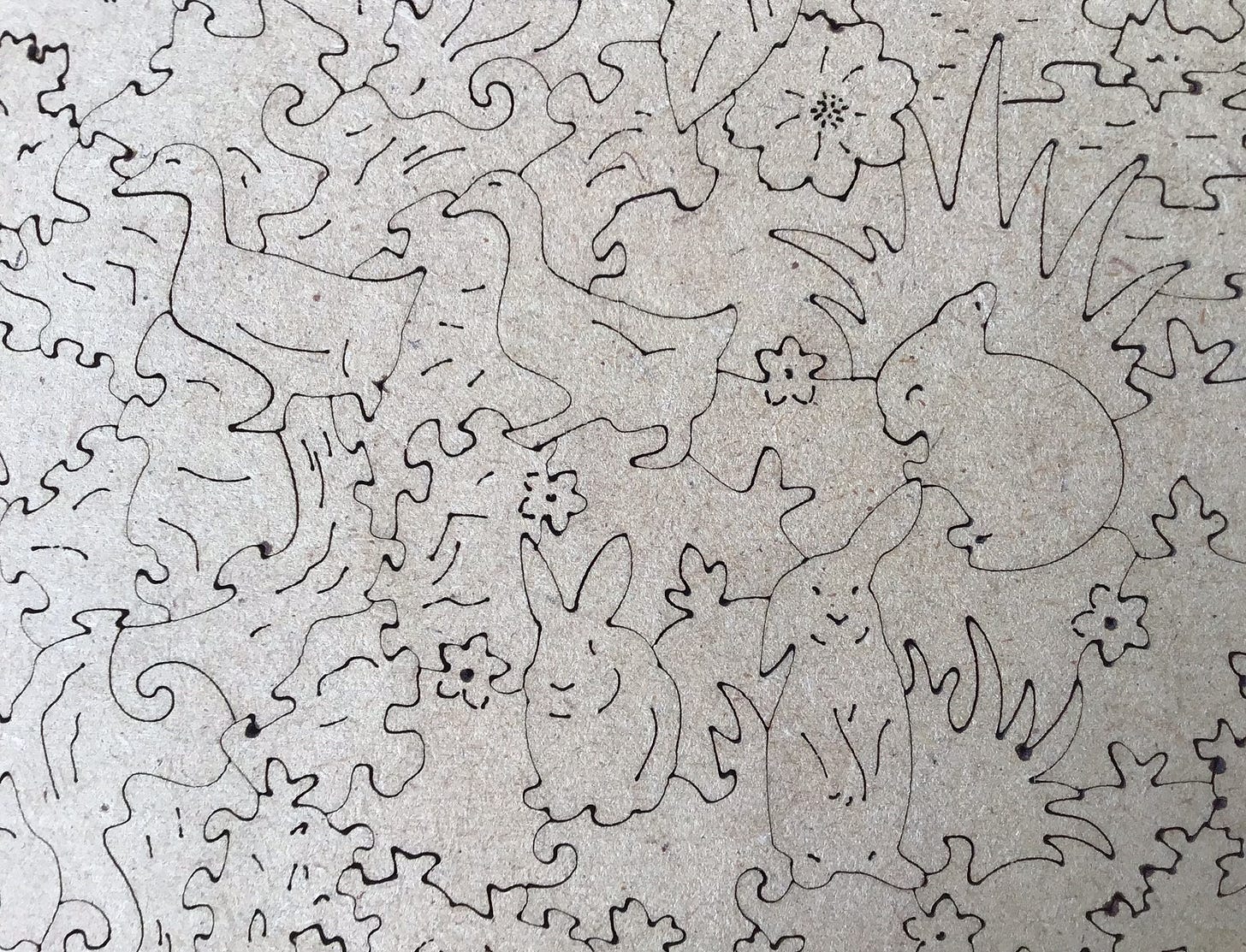
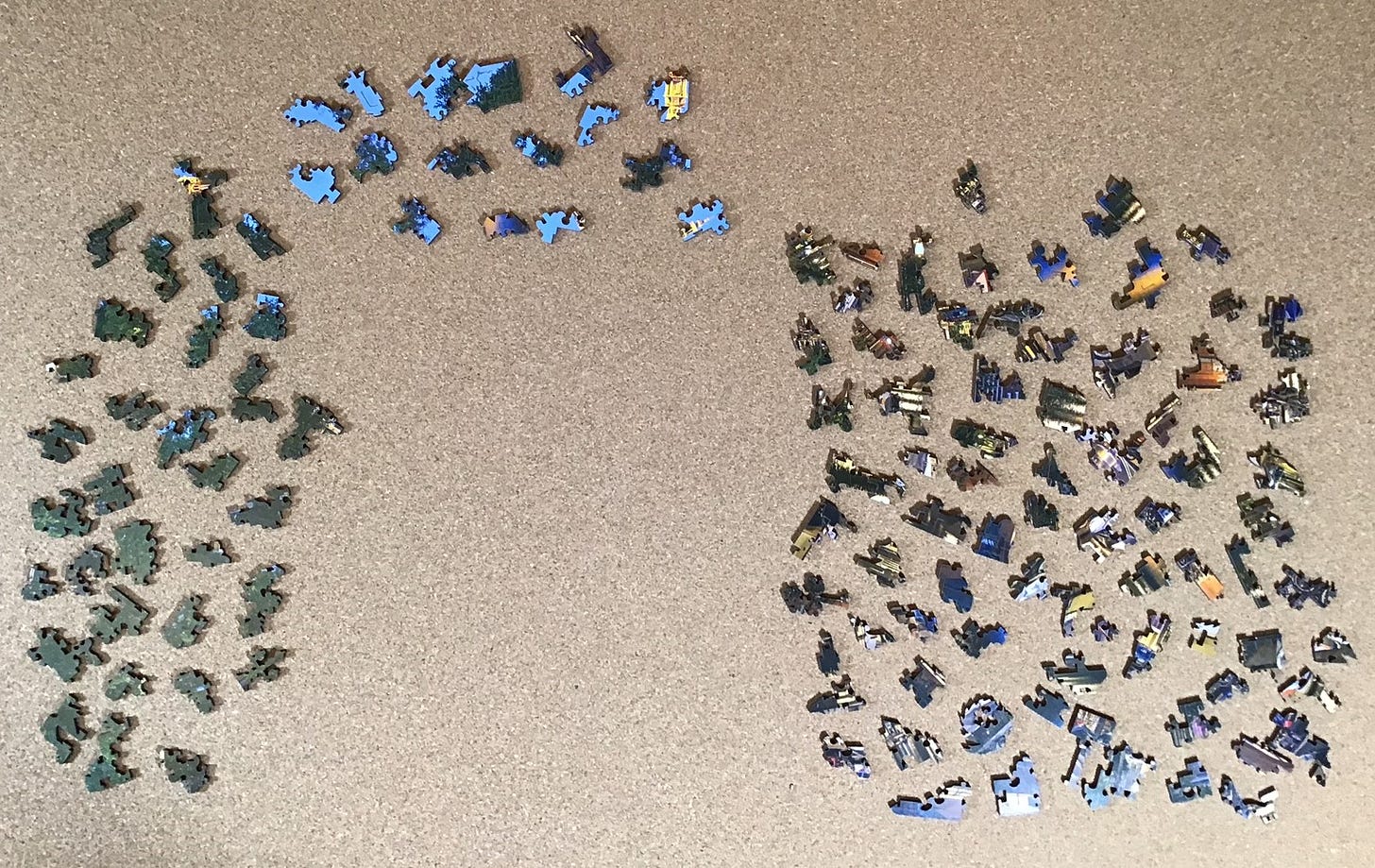
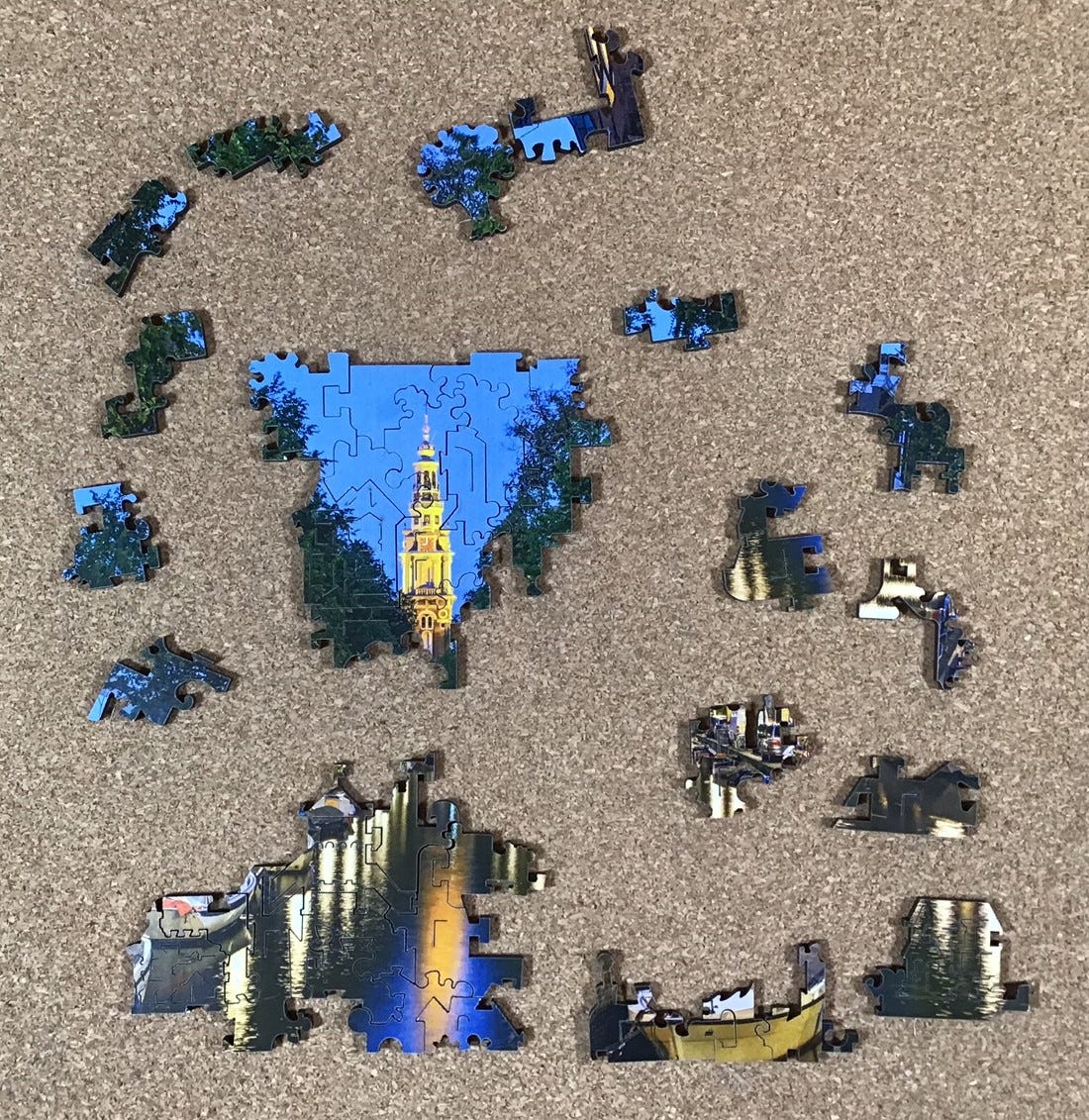

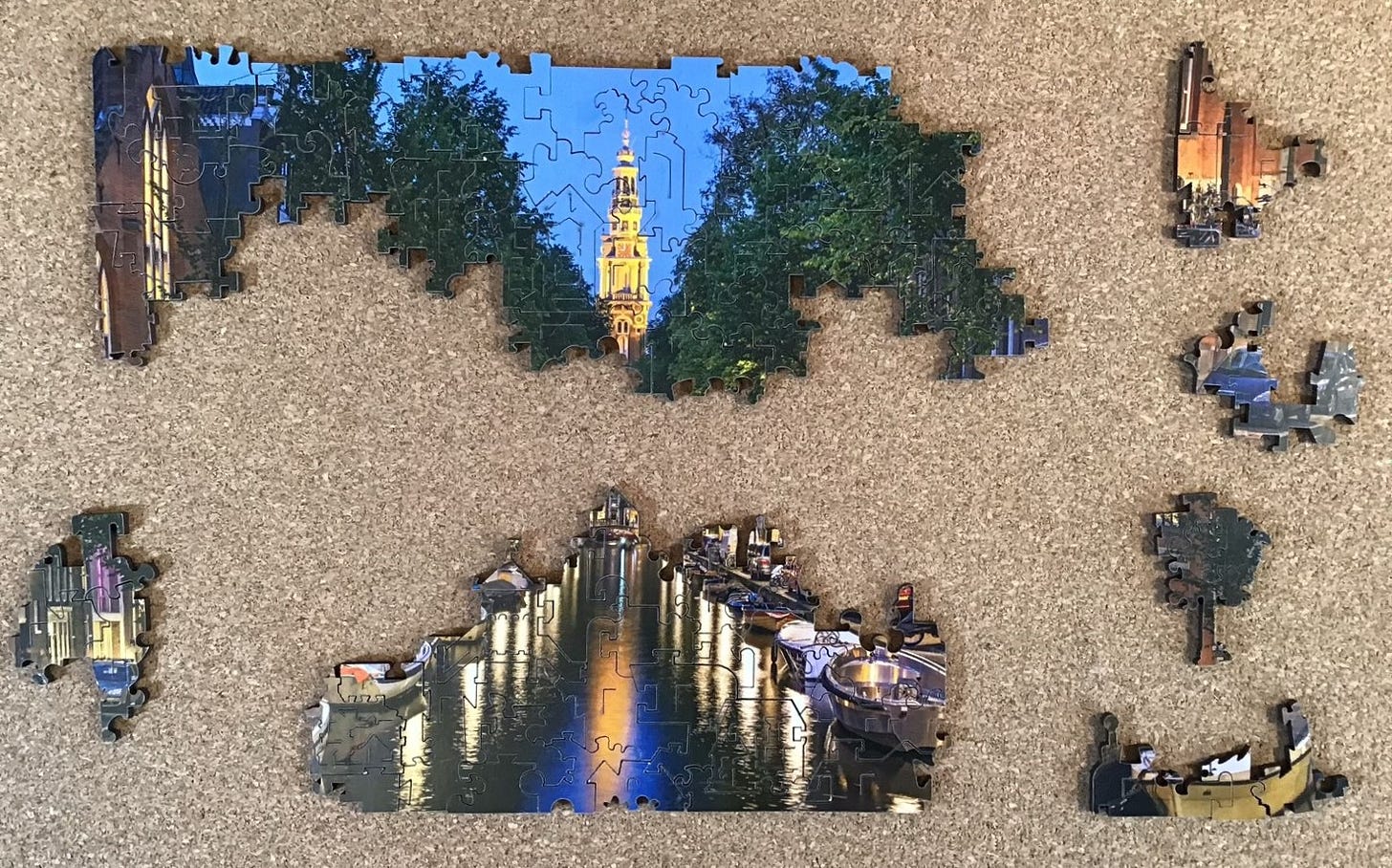
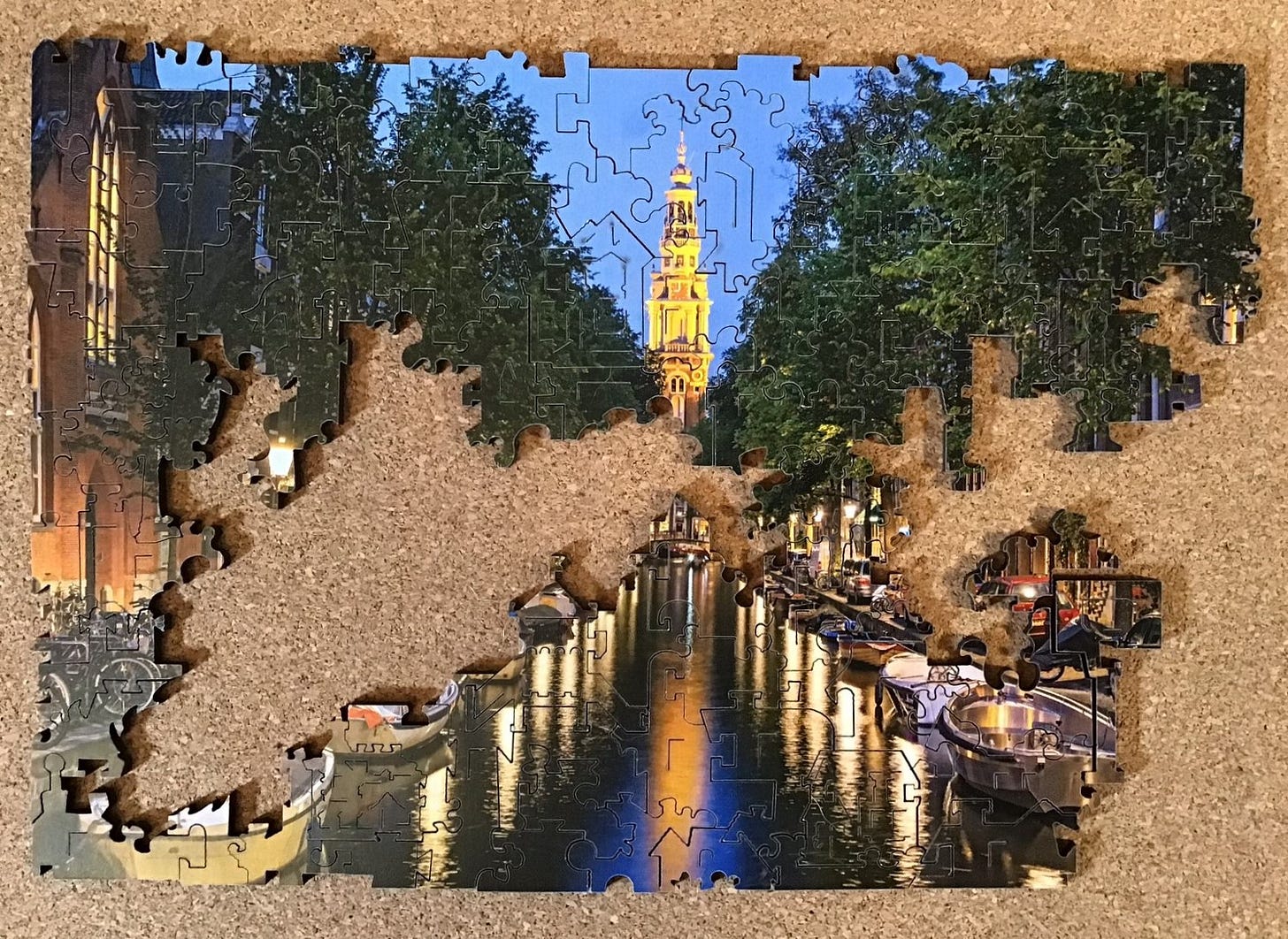
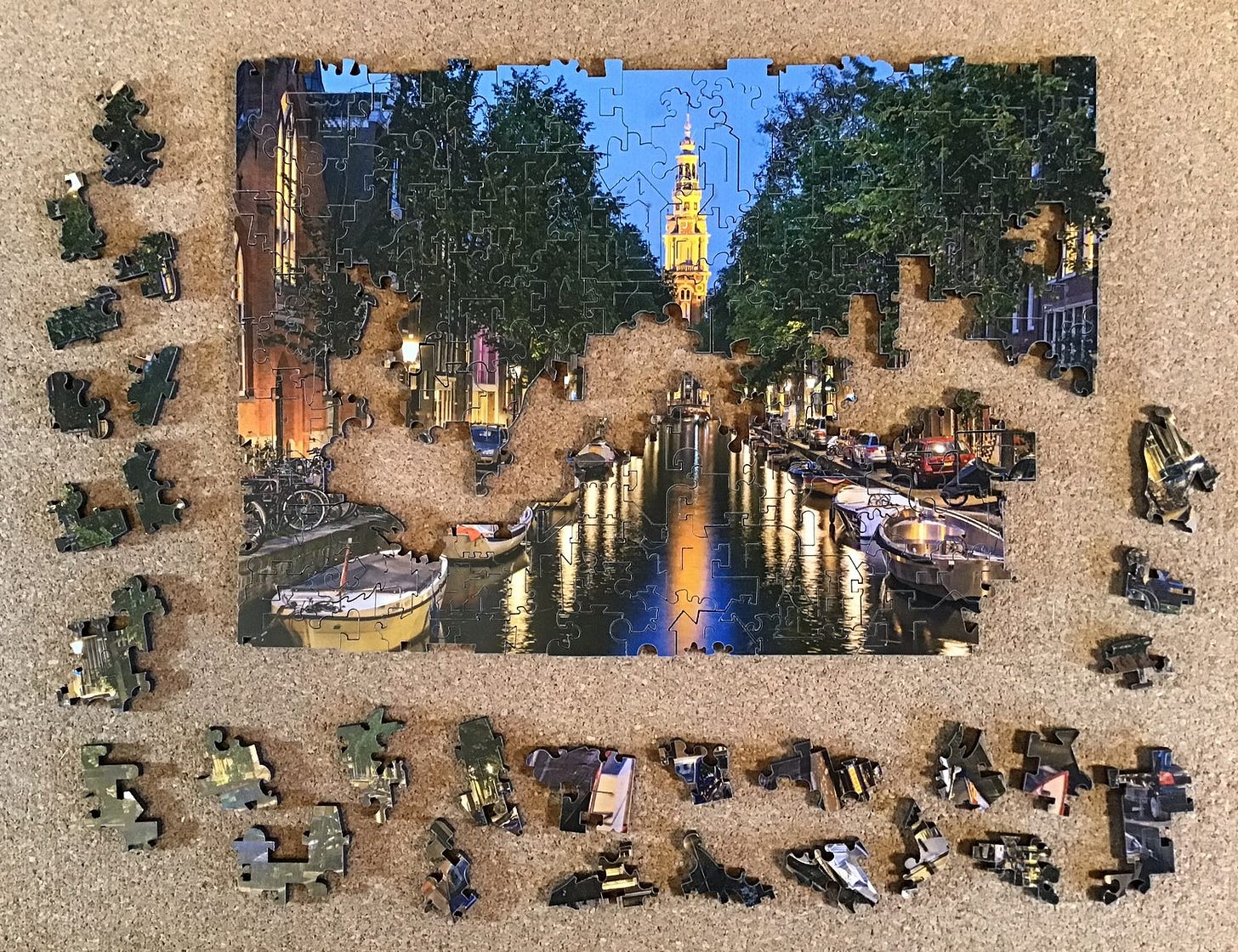
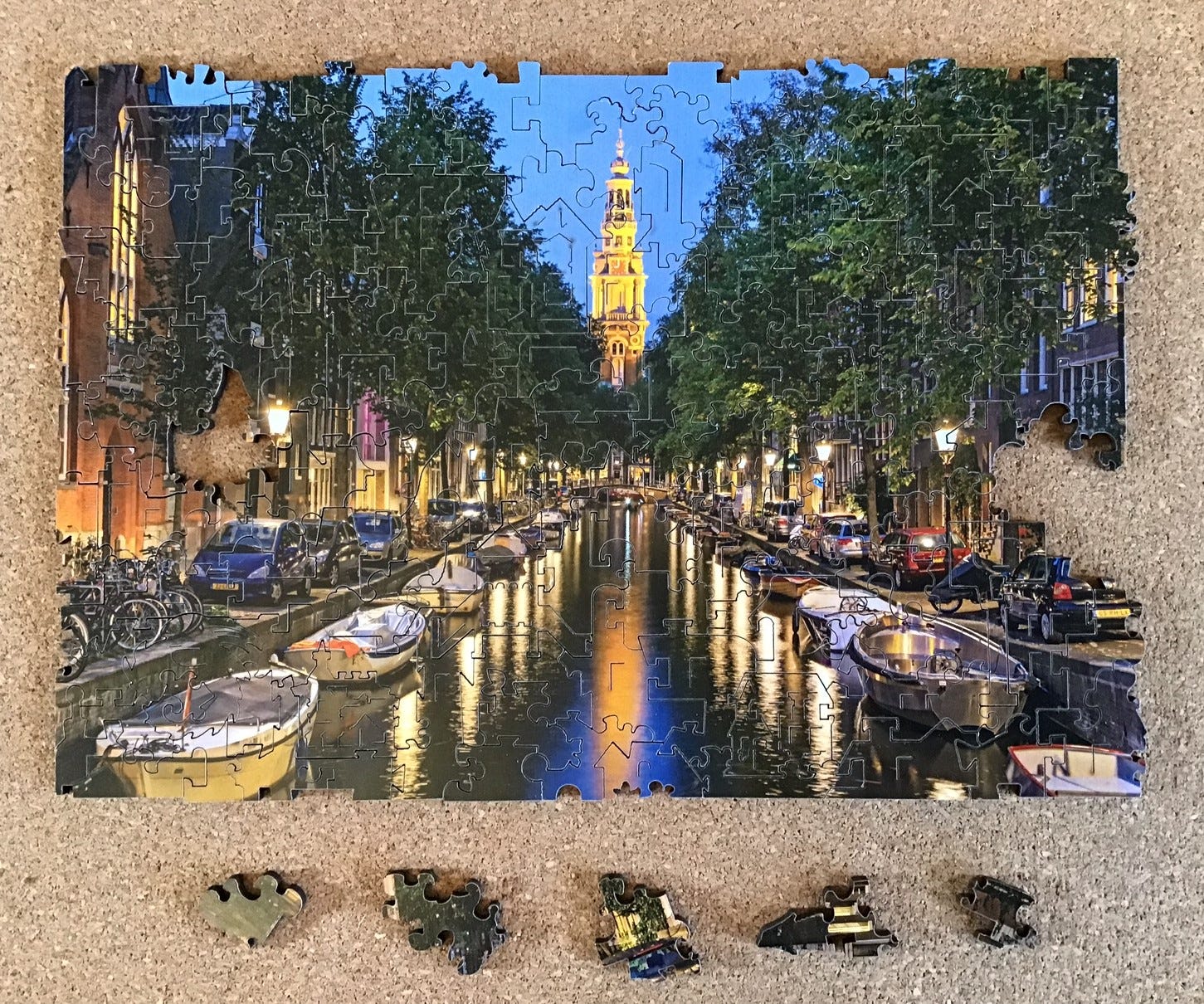
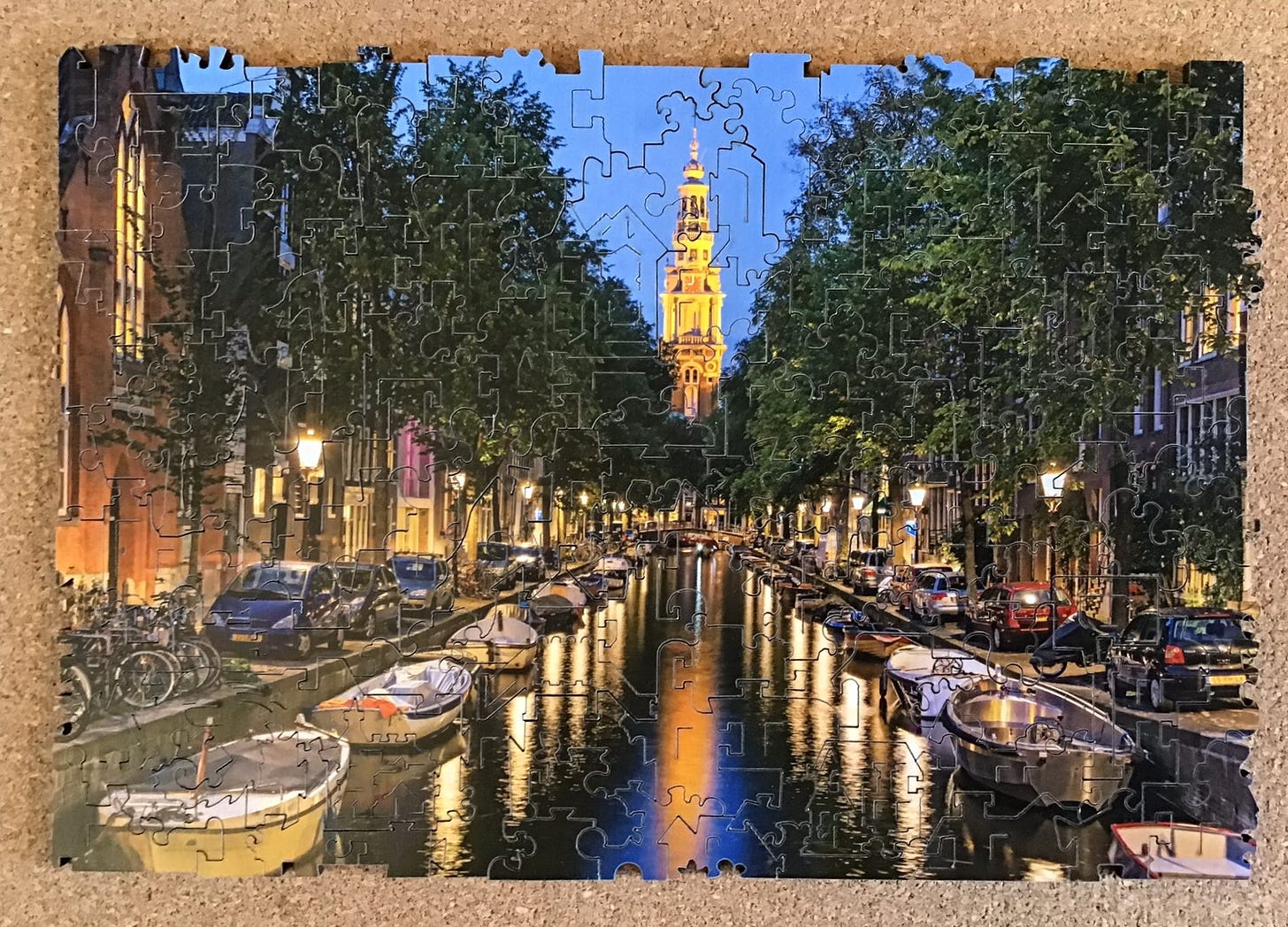
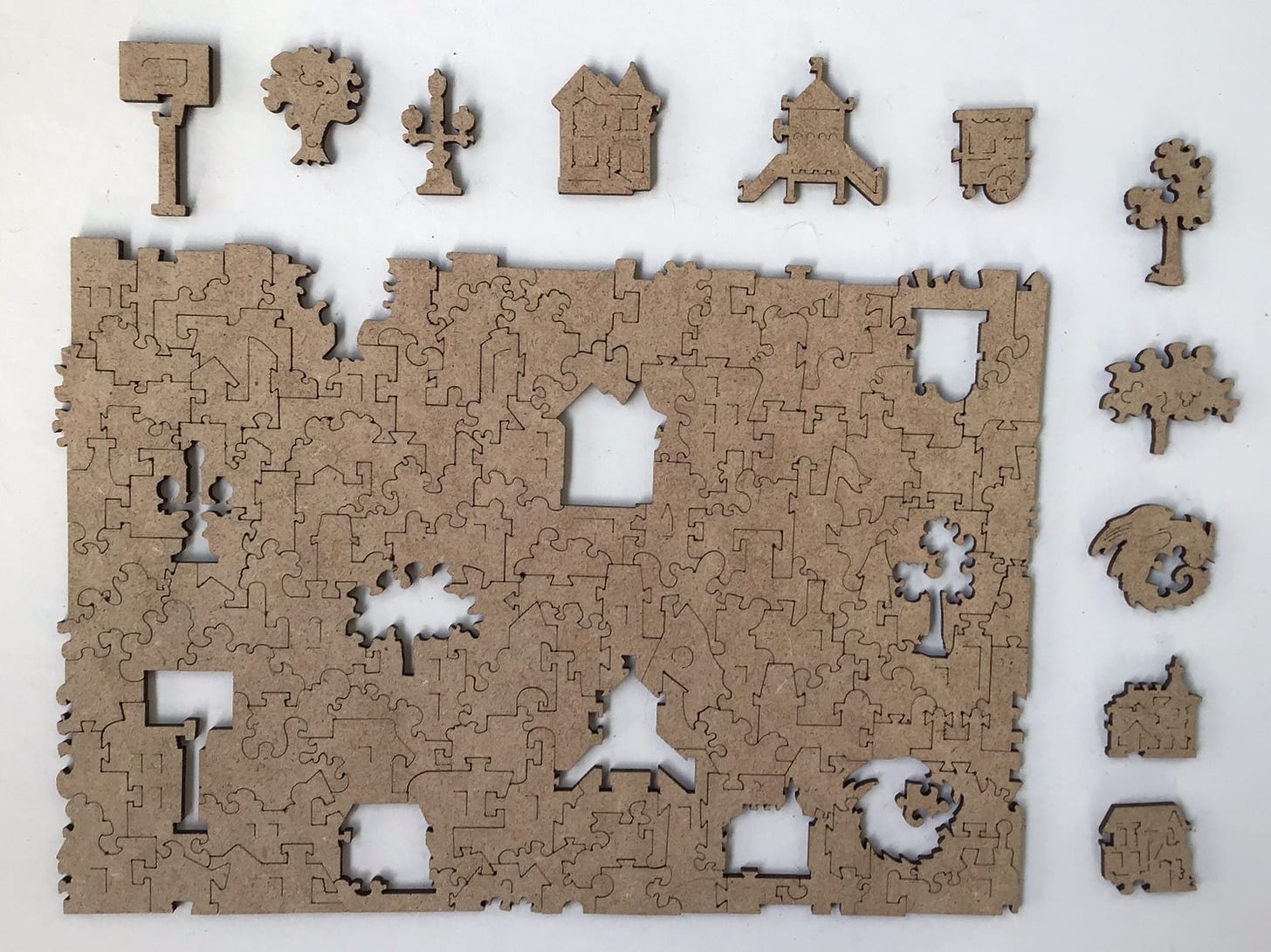
Although I had previously owned and assembled wooden jigsaw puzzles before, Unidragon's "Fiery Fox," which you kindly gifted to my wife and me two Christmases ago, was my first laser-cut wooden jigsaw puzzle with pieces that fit tightly together. I hadn't even been aware of such laser-cut products, though I had assembled a great many jigsaw puzzles made of cardboard over the course of eight different decades. We were quite delighted by "Fiery Fox," and we felt proud that it seems to have played a role in your burgeoning wooden-jigsaw-puzzle hobby (including your blog) after we happily loaned that puzzle back to you. I also was, and still am, very impressed by the seeming care and sophistication displayed by the Unidragon company.
While assembling "Fiery Fox," we noticed that, even with its moderate total number of pieces (308), the puzzle was satisfyingly challenging, and we spread our enjoyment of assembling it over five days. The shapes of the whimsy pieces visible from the front, plus the "extra" sketches visible on the back once the completed puzzle was flipped over, added to our pleasure. Our talk about our experience with "Fiery Fox" also inspired our daughter and her husband to become interested in a different Unidragon puzzle.
As usual, your posted essay is comprehensive, Bill! My favourite images, after those of "Fiery Fox," are the one of the completed "City Evening Amsterdam" and the one of Zmei Gorynich.